Frank F. Weber's Blog, page 14
April 8, 2019
Racial History & Somali Immigrants in St. Cloud. Islands in the stream.

 The Herd Boy, painted by Frederick Remmington in 1905, depicts the struggle surviving the harsh winter. A brief history of Upper town, St. Cloud. It’s an area of St. Cloud now referred to by many, right or wrong, as Somaliville. It’s just a couple blocks west of the trainyard, making it a tough area of town long before the Somalis arrived. Like most poor immigrants, the Somalis settled in an area where the rent was cheap, as did poverty stricken German Catholics before them. Few St. Cloud residents realize that before the Catholics became the majority in this neighborhood, there were even worse off Africans living in this area of St. Cloud.
The Herd Boy, painted by Frederick Remmington in 1905, depicts the struggle surviving the harsh winter. A brief history of Upper town, St. Cloud. It’s an area of St. Cloud now referred to by many, right or wrong, as Somaliville. It’s just a couple blocks west of the trainyard, making it a tough area of town long before the Somalis arrived. Like most poor immigrants, the Somalis settled in an area where the rent was cheap, as did poverty stricken German Catholics before them. Few St. Cloud residents realize that before the Catholics became the majority in this neighborhood, there were even worse off Africans living in this area of St. Cloud. In 1850, Kentucky General Sylvanus Lowry moved, slaves and all, to Upper town St. Cloud along with a number of other southern slave owners. Lowry became the first Mayor of St. Cloud in 1856.
People in the area opposing slavery got a voice when a young woman who was both an abolitionist and newspaper editor migrated from Pittsburgh to St. Cloud. Jane Grey Swisshelm repeatedly attacked Lowry’s slave practices, and his treatment of the Winnebago Indians, in print. Lowry responded by organizing a "Committee of Vigilance" that broke into Swisshelm's newspaper office and threw her press into the Mississippi river. The vandals left behind a letter, “The citizens of St. Cloud have determined to abate this nuisance for which you have made the ‘Visiter’ a prime specimen (in reference to the St. Cloud Visitor newspaper), fit only for the inmates of brothels, and you seem to have had some experience of the tastes of such persons.” Jane Grey Swisshelm identified the handwriting as that of Sylvanus B. Lowry, Democratic political boss of St. Cloud.
But Swisshelm continued to speak her mind. As Ida B. Wells once said, “The way to right things is to turn the light of truth on them.” Jane and Ida Wells are pictured below.
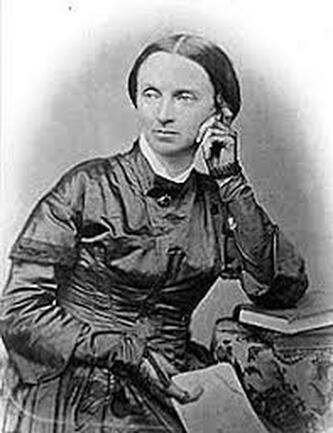
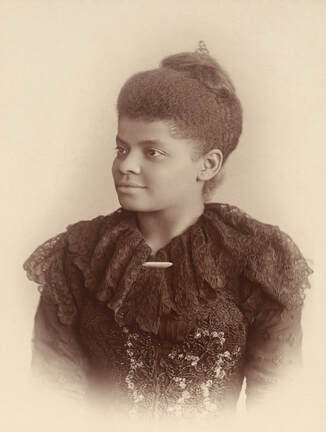 The southerners, and their slaves, left St. Cloud and moved back south when the civil war broke out. Jane Grey Swisshelm moved back east and worked as a nurse for the Union in the Civil War. Jane continued to publish support for Abraham Lincoln. She was hired for government press after the war, but was fired for publicly criticizing Andrew Johnson. In my opinion, the criticism was warranted as it was Johnson who allowed the Jim Crowe laws to emerge - such as vagrancy laws that enabled southern slave owners to arrest Africans for being unemployed, and then force them to work as slaves to pay off their debt to society. (The plantation owners argued that the slavery freedoms didn’t apply, because they weren’t being forced to work because of their race, but instead because they were guilty of a crime.)
The southerners, and their slaves, left St. Cloud and moved back south when the civil war broke out. Jane Grey Swisshelm moved back east and worked as a nurse for the Union in the Civil War. Jane continued to publish support for Abraham Lincoln. She was hired for government press after the war, but was fired for publicly criticizing Andrew Johnson. In my opinion, the criticism was warranted as it was Johnson who allowed the Jim Crowe laws to emerge - such as vagrancy laws that enabled southern slave owners to arrest Africans for being unemployed, and then force them to work as slaves to pay off their debt to society. (The plantation owners argued that the slavery freedoms didn’t apply, because they weren’t being forced to work because of their race, but instead because they were guilty of a crime.)Even though there were slaves in St. Cloud, the majority of Minnesotans were anti-slavery. In1864, active abolitionist and St. Cloud resident, Stephen Miller, was elected Minnesota governor. Miller is the only citizen of St. Cloud ever to hold the office. Miller was a German businessman.
Before that, Upper St. Cloud was a waystation on the Middle and Woods branches of the Red River Trails. Before the railroads, the Red River Trails were the most efficient way to send goods across the Midwest. The trails were used by Metis traders between Canada and St. Paul.
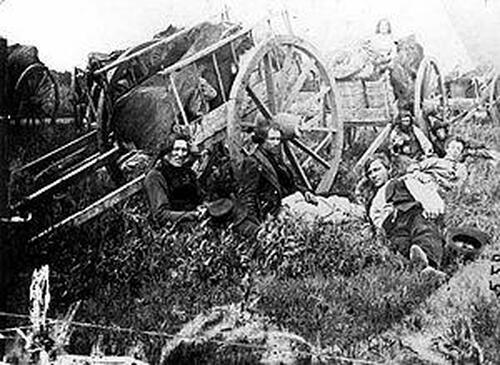 The cart trains often consisted of hundreds of oxcarts. Because nails were unavailable, or expensive, these carts contain no iron at all, being entirely constructed of wood and animal hide. The cart can be dismantled, the wheels covered with bison hides to make floats and the box placed on top. Thus the cart can be floated across streams. Red River carts are strong enough to carry loads as heavy as 1,000 pounds. The Metis, bringing furs to trade for supplies to take back to their rural settlements, would camp west of the city and cross the Mississippi in St. Cloud or just to the north in Sauk Rapids. The Metis were great examples of integration, being half Native American and half European American. There was a Metis colony in the Red River Valley in northern Minnesota. The Hudson Bay company began moving in settlers who were both ant-Metis and anti-Catholic. Ultimately, Canada developed laws to allow the Metis their own schools and to protect Catholics in expression of their faith. The Metis colony moved to Manitoba, right across the border of northwestern Minnesota.
The cart trains often consisted of hundreds of oxcarts. Because nails were unavailable, or expensive, these carts contain no iron at all, being entirely constructed of wood and animal hide. The cart can be dismantled, the wheels covered with bison hides to make floats and the box placed on top. Thus the cart can be floated across streams. Red River carts are strong enough to carry loads as heavy as 1,000 pounds. The Metis, bringing furs to trade for supplies to take back to their rural settlements, would camp west of the city and cross the Mississippi in St. Cloud or just to the north in Sauk Rapids. The Metis were great examples of integration, being half Native American and half European American. There was a Metis colony in the Red River Valley in northern Minnesota. The Hudson Bay company began moving in settlers who were both ant-Metis and anti-Catholic. Ultimately, Canada developed laws to allow the Metis their own schools and to protect Catholics in expression of their faith. The Metis colony moved to Manitoba, right across the border of northwestern Minnesota. Before the Metis were resting on the banks of the Mississippi, the St. Cloud area was the home of various indigenous peoples for thousands of years, including the Anishinaabe, Ottawa and Winnebago/Ho-Chunk peoples. The Anishinaabe are one of the largest groups of indigenous people today. The native American population in the U.S. increased 27% from the 2000 to the 2010 census, with most being Cherokee or Navajo, and 75% integrated (not living on reservations).
I want to come back to where I started. There has been difficulty between Somalis and other ethnic groups in St. Cloud. Last week I met with psychologists from all over the world at a conference at Rice University in Houston, Texas. A psychologist from Kenya asked me if the Somalis were having difficulties getting along with other groups in St. Cloud. When I said there are some issues, she commented, “That doesn’t surprise me. The Somalis have difficulty getting along with all other groups in Africa. I think it’s because Somalia has never had a strong leader. The people are reluctant to take direction from anyone.”
I responded that it’s always come down to individuals to me. There are people of every race I like, and dislike. But I also want to point out that I wouldn’t have included the above quote if I hadn’t heard similar comments voiced by others from Africa. I think the St. Cloud Somali situation will take some creative efforts from all ethnic groups to resolve.


 The Beaver Island Brewing company is hosting my big The I-94 Murders event at 6:00 p.m. on Tuesday, April 23. This is going to be a blast and there is no cost. Stop in and have a cold beverage. I’ll speak from 6:00 to 7:00 about writing True Crime mysteries and you can get questions answered about forensic psychology. Where are the Beaver Islands? The Beaver Islands are the uninhabited islands of the Mississippi around St. Cloud that people love to kayak out to. (They were given their name by explorer Zebulon Pike. People just don't name their kids Zebulon anymore.)
The Beaver Island Brewing company is hosting my big The I-94 Murders event at 6:00 p.m. on Tuesday, April 23. This is going to be a blast and there is no cost. Stop in and have a cold beverage. I’ll speak from 6:00 to 7:00 about writing True Crime mysteries and you can get questions answered about forensic psychology. Where are the Beaver Islands? The Beaver Islands are the uninhabited islands of the Mississippi around St. Cloud that people love to kayak out to. (They were given their name by explorer Zebulon Pike. People just don't name their kids Zebulon anymore.)
Depending on the water level there is somewhere between 15 to 30 islands. I would say 15, but 30 if you count sand bars. There were actually bridges built between some of the islands decades ago, but they now cease to exist. Most are owned by St. Cloud State University, who actually built an athletic field on the largest island at one point, but it’s now grown over. (It wasn’t particularly convenient.) The Beaver Islands were used for camping and picnics for a bit, but that has also been abandoned. The St. Cloud Country Club owns the island closest to the club.
 Alicia Isom is featured on the cover of The I-94 Murders. I had the opportunity to visit the Vincent Van Gogh exhibit at the Fine Arts Museum in Houston, Texas, last week. I love how Van Gogh carefully painted the people in poverty he lived around, including the cracks on their hands. Van Gogh painted a family of potato farmers and spoke of respecting hard-working people who earned their meals. It is interesting to note how the pictures that are the most distorted were painted right before mental health breakdowns that led to asylum placements. It was interesting to read through Vincent’s notes and consider the frustration of painting on rickety easels on windy days. Vincent was close to his brother and worried when his brother started a family that his brother would continue to try to assist him. He ultimately committed suicide and died in his brother’s arms. I found incredible genius in his work and I appreciated that the museum included his notes and identified where he was at when each portrait was painted.
Alicia Isom is featured on the cover of The I-94 Murders. I had the opportunity to visit the Vincent Van Gogh exhibit at the Fine Arts Museum in Houston, Texas, last week. I love how Van Gogh carefully painted the people in poverty he lived around, including the cracks on their hands. Van Gogh painted a family of potato farmers and spoke of respecting hard-working people who earned their meals. It is interesting to note how the pictures that are the most distorted were painted right before mental health breakdowns that led to asylum placements. It was interesting to read through Vincent’s notes and consider the frustration of painting on rickety easels on windy days. Vincent was close to his brother and worried when his brother started a family that his brother would continue to try to assist him. He ultimately committed suicide and died in his brother’s arms. I found incredible genius in his work and I appreciated that the museum included his notes and identified where he was at when each portrait was painted. Thanks for listening,
Frank
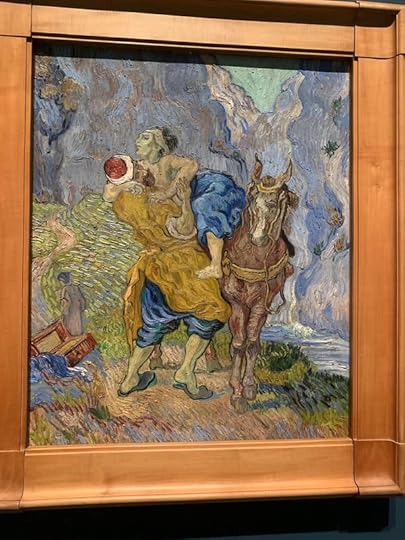 1890 The Good Samaritan by Vincent Van Gogh
1890 The Good Samaritan by Vincent Van Gogh 


 This was painted right before he was placed in an asylum. The paintings represent his mental health at the time.
This was painted right before he was placed in an asylum. The paintings represent his mental health at the time. 







 Self portrait
Self portrait  1874 Twilight in the Tropics by Frederic Church
1874 Twilight in the Tropics by Frederic Church  1900 The End of the Day by William Kendall
1900 The End of the Day by William Kendall  1905 Stained glass art by Louis Tiffany. Tiffany later joined with Arthur Nash to develop the successful “Tiffany’s” stained glass store.
1905 Stained glass art by Louis Tiffany. Tiffany later joined with Arthur Nash to develop the successful “Tiffany’s” stained glass store.  1615 Saint John the Baptist by Jusepe de Ribera. John is frequently depicted as a handsome youth who lived in the desert and focused on prayer and meditation.
1615 Saint John the Baptist by Jusepe de Ribera. John is frequently depicted as a handsome youth who lived in the desert and focused on prayer and meditation.  1935 This is a portable phonograph RCA Victor Special Model M, made by John Vassos and Alfred Weiland.
1935 This is a portable phonograph RCA Victor Special Model M, made by John Vassos and Alfred Weiland.  1620 Kitchen Maid by Diego Rodiguez de Silva
1620 Kitchen Maid by Diego Rodiguez de Silva 

Published on April 08, 2019 17:13
April 3, 2019
The Premiere St. Cloud event on The I-94 Murders


 The Premiere St. Cloud event on The I-94 Murders
The Premiere St. Cloud event on The I-94 Murders  On Tuesday, April 23, 2019, a waning crescent moon will hang over St. Cloud.
On Tuesday, April 23, 2019, a waning crescent moon will hang over St. Cloud.  Beaver Island Brewing Company will be opening their doors on a Tuesday night.
Beaver Island Brewing Company will be opening their doors on a Tuesday night.  Frank Weber will be speaking on The I-94 Murders, writing True Crime mysteries, and forensic work from 6:00 to 7:00, and will be answering questions and signing books after. Books will be available to purchase. This is a great opportunity to relax with a cold beverage and talk a little murder mystery. The taproom is opening for this event. It is open to the public. Forensic psychologist writes mystery novels by Joni Astrup, Associate Editor
Frank Weber will be speaking on The I-94 Murders, writing True Crime mysteries, and forensic work from 6:00 to 7:00, and will be answering questions and signing books after. Books will be available to purchase. This is a great opportunity to relax with a cold beverage and talk a little murder mystery. The taproom is opening for this event. It is open to the public. Forensic psychologist writes mystery novels by Joni Astrup, Associate EditorElk River Star News, Mar 17, 2019
 Author Frank Weber talked about his books and his work as a forensic psychologist during a recent visit to the Elk River Library. In the background is promotional material for his book, “The I-94 Murders.” Photo by Joni Astrup As a forensic psychologist, Frank Weber’s day job has involved doing psychological assessments in homicide, sexual assault and domestic abuse cases. His work has ranged from assessing murderers and psychopaths to providing therapy for wealthy professionals who’ve engaged in multiple affairs to testifying as an expert witness. Frank Weber showed a photo under consideration for use in his newest book, “Last Call.”
Author Frank Weber talked about his books and his work as a forensic psychologist during a recent visit to the Elk River Library. In the background is promotional material for his book, “The I-94 Murders.” Photo by Joni Astrup As a forensic psychologist, Frank Weber’s day job has involved doing psychological assessments in homicide, sexual assault and domestic abuse cases. His work has ranged from assessing murderers and psychopaths to providing therapy for wealthy professionals who’ve engaged in multiple affairs to testifying as an expert witness. Frank Weber showed a photo under consideration for use in his newest book, “Last Call.” Faced with the stresses of that work, he started writing murder mysteries as a way to vent. His wife encouraged him to send one of his manuscripts to a publisher, and his first book, “Murder Book,” was published in 2017. A second book, “The I-94 Murders,” came out in 2018 and a third, “Last Call,” will likely come out this fall. “It’s been a fun ride,” he told an audience during a recent appearance at the Elk River Library, where he talked about his books and his work as a forensic psychologist.
Faced with the stresses of that work, he started writing murder mysteries as a way to vent. His wife encouraged him to send one of his manuscripts to a publisher, and his first book, “Murder Book,” was published in 2017. A second book, “The I-94 Murders,” came out in 2018 and a third, “Last Call,” will likely come out this fall. “It’s been a fun ride,” he told an audience during a recent appearance at the Elk River Library, where he talked about his books and his work as a forensic psychologist.  Frank Weber’s first book, “Murder Book,” was published in 2017. “Murder Book” was nominated for Best Romance and Best Murder Mystery last year by Midwest Independent Publishers, and the reviews have been very good, he said. The main character in his books is Jon Frederick, a Minnesota Bureau of Criminal Apprehension investigator.
Frank Weber’s first book, “Murder Book,” was published in 2017. “Murder Book” was nominated for Best Romance and Best Murder Mystery last year by Midwest Independent Publishers, and the reviews have been very good, he said. The main character in his books is Jon Frederick, a Minnesota Bureau of Criminal Apprehension investigator.While the books are fictional, Weber draws on fact in weaving his tales. “Murder Book,” was inspired by a real-life homicide case. “The I-94 Murders” is loosely based on the profile of a true-life serial murderer. Weber also uses real places in his books. The I-94 Murders starts out away from I-94, in the central Minnesota town of Buckman.
All the forensics in his books are also accurate. He said he likes to introduce advances in forensics that are likely new to readers.
 “I-94 Murders,” Frank Weber’s second book, came out in 2018. Weber said investigators are in a better position to solve cases now than ever before, in part due to DNA, cellphones, cameras and other things. “Cellphones are wonderful, because they’re always hitting on towers and so they put people in locations,” he said. The prevalence of cameras — in neighborhoods, at gas stations and at many other locations — also helps solve crimes. Advances have been made in other areas as well.
“I-94 Murders,” Frank Weber’s second book, came out in 2018. Weber said investigators are in a better position to solve cases now than ever before, in part due to DNA, cellphones, cameras and other things. “Cellphones are wonderful, because they’re always hitting on towers and so they put people in locations,” he said. The prevalence of cameras — in neighborhoods, at gas stations and at many other locations — also helps solve crimes. Advances have been made in other areas as well.Weber, meanwhile, is a native of Pierz, Minnesota, and has a master’s degree in Clinical psychology from St. Cloud State University. He said his job has taken him to every prison and almost every jail in Minnesota.
One of his strangest interviews took place at a prison where he was taken to a room in the basement that contained two plastic chairs and a metal plate in the floor. The inmate he was to assess was brought in, seated in one of the chairs and chained to the floor. The extra precautions were because the man was suspected of killing a gang member a day earlier.
In conducting an assessment, Weber said he never lets the person talk about the offense to start out with because typically they have been rehearsing a story that they want to tell him quickly, so they don’t forget it. He said the most effective way to get information is to have a conversation about everything from relationships, work history and school history to medical history, sexual history and criminal history.
“I truly believe psychopaths are made, not born,” he said. “If you go through this history, you start to get an understanding of how it all played out.” For more information about Weber and his books, go to frankweberauthor.com. I would like people to watch this 3 minute cartoon. If you’re wondering why there’s a gray haired bare chested man in the video, the makers of the video decided to present Valdimir Putin in this manner. (66 year old Vladimir published bare chested pictures videos of himself last October to impress the public. Little bit of narcissism there Vlad!) Russia isn’t focused on Trump or Hillary, they’re focused on us. It had my curiosity when I read that a lot of the Russian hacks were about Black Lives Matter. They would go online and post comments trying to aggravate both sides. The goal is to get Americans too angry to talk to each other. Don’t let them win!
Thanks for listening,
Frank
 JOBS | BRAND LIBRARY
JOBS | BRAND LIBRARYWe make beers that people don't just drink - they tell stories about. We're obsessed with the art of brewing, and aren't afraid to work harder than the other guys. At the end of the day, this is about respect - for the ingredients, for the tradition, and for the vision and experience needed to turn it all into the perfect beer.
CONTACT US
Address: 216 6th Ave S
St Cloud, MN 56301
Phone: 320 253 5907
Email: info@beaverislandbrew.com
Published on April 03, 2019 07:27
March 26, 2019
Modern Day Romeo and Juliet
The tragedy of Noor al-Maleki and Marwan Alebadi
When you consider what Fundamentalist Muslim Faleh al-Maleki did with his daughter (before he murdered her), it was basically sex trafficking.
Noor al-Maleki fled Bazra, Iraq when she was 4 years old and moved to Phoenix, Arizona. Noor was on the tennis team in school and was in Yearbook. At home, Noor was supposed to obey her parents. It was her job to cook, clean and help take care of her six younger siblings. A friend reported, "And if she didn't she would be beaten."
Faleh al-Maleki arranged for his daughter, Noor, to marry his much older cousin in Iraq. Faleh had accumulated a large casino debt and traded his daughter for a dowry to pay off the debt. Noor was sent to Iraq, at age 17, while the U.S. was bombing the country. Noor admitted that the marriage was traumatic, and that during the bombings she would stand in the middle of her house, hoping to be struck by a bomb.

 In 2008, Noor was 19 years old, and was allowed to return to the U.S. Her parents insisted she abide by fundamentalist Muslim procedures. When they found a picture of her next to a boy, fully clothed (not engaging in any romantic behavior), on Myspace, her father beat her. Noor left the home and tried to kill herself in a car accident. She braked at the last minute and survived.
In 2008, Noor was 19 years old, and was allowed to return to the U.S. Her parents insisted she abide by fundamentalist Muslim procedures. When they found a picture of her next to a boy, fully clothed (not engaging in any romantic behavior), on Myspace, her father beat her. Noor left the home and tried to kill herself in a car accident. She braked at the last minute and survived.  Noor moved in with an Iraqi family friend, Amal Khalaf. She met Marwan Alebadi, a street gang member related to Amal, and he began expressing sympathy for her. Noor was hoping to pursue an education and Amal seemed to be stepping away from his criminal past. Her father, Faleh al-Maleki, didn’t feel women should work, so he would walk into her jobs and complain until she was fired. Faleh reported Noor’s car (which was in his name) stolen, and Noor was forced to move back home. Noor was beaten by both her mother and father, in their efforts to make her “a good Iraqi girl.”
Noor moved in with an Iraqi family friend, Amal Khalaf. She met Marwan Alebadi, a street gang member related to Amal, and he began expressing sympathy for her. Noor was hoping to pursue an education and Amal seemed to be stepping away from his criminal past. Her father, Faleh al-Maleki, didn’t feel women should work, so he would walk into her jobs and complain until she was fired. Faleh reported Noor’s car (which was in his name) stolen, and Noor was forced to move back home. Noor was beaten by both her mother and father, in their efforts to make her “a good Iraqi girl.”
In 2009, Noor came home to find all of her clothes lying in the street. Her parents had discovered she was secretly engaged to Marwan. Noor moved back in with Amal. Faleh al-Maleki burst into the home to take Noor back home once again. But the police were called and Faleh was removed from the home. He threatened “bad things will happen.” Noor’s mother, Sahen, told Noor she keeps a voodoo doll she punishes, representing Noor.
 Faleh al-Maleki found Amal and Noor at the welfare office and waited for them outside. Amal had locked her keys in the car so she called Marwan to bring another set. When Amal and Noor step into the street, Faleh al-Maleki accelerated and drove his vehicle into both women. He had to swerve to run over his daughter. When the police tell Noor’s mother, Sahen, that Noor was dying, Sahen said, “Good.” Sahen further remarks that if she didn’t die they may send someone to finish the job. Noor was placed under 24-hour police protection. Sahen prohibited Marwan from visiting her daughter. Marwan does manage to get a couple visits through empathetic police officers.
Faleh al-Maleki found Amal and Noor at the welfare office and waited for them outside. Amal had locked her keys in the car so she called Marwan to bring another set. When Amal and Noor step into the street, Faleh al-Maleki accelerated and drove his vehicle into both women. He had to swerve to run over his daughter. When the police tell Noor’s mother, Sahen, that Noor was dying, Sahen said, “Good.” Sahen further remarks that if she didn’t die they may send someone to finish the job. Noor was placed under 24-hour police protection. Sahen prohibited Marwan from visiting her daughter. Marwan does manage to get a couple visits through empathetic police officers.
Faleh al-Maleki told police, “If a small part of your house starts on fire, you must put that fire out before it burns down the whole house.” A recorded conversation between Noor’s parents revealed a discussion over how they should have taken more time killing their daughter.
On November 2, 2009, Noor al-Maleki died in the hospital. Faleh al-Maleki was sentenced to 37 years in prison. Faleh’s argument was that he killed his daughter to protect the family’s honor. I really dislike the term “honor killings” because there is no honor in killing another person because you felt embarrassed. Victims of “honor killings” in the U.S.
Victims of “honor killings” in the U.S.
It’s estimated that 5,000 honor killings occur each year globally, with most occurring in the Middle East, North Africa and South Asia.
A weird aside related to this case: Marwan deteriorated back into crime after Noor’s death. He has been incarcerated and recently was arrested after one of the worst escape attempts ever.
Officers in Peoria, Arizona approached Marwan Al Ebadi, 28, and Salma Hourien, 29, at a gas station at 6:10 p.m. February 16, 2018, while investigating a possible shoplifting, and they took off running. Trying to elude pursuing cops, the couple hopped a nearby fence. The fence surrounded a clearly marked Peoria Police Department station. Marwan and his new woman friend ended up in a secure parking lot where officers were conducting a training exercise.
Trying to elude pursuing cops, the couple hopped a nearby fence. The fence surrounded a clearly marked Peoria Police Department station. Marwan and his new woman friend ended up in a secure parking lot where officers were conducting a training exercise.
Thanks for listening,
Frank April 11, 2019. Frank will be providing an all-day training to licensed law enforcement officers on Addressing Mental Illness Effectively from 8:00-4:30 p.m. at Central Lakes College sponsored by the Criminal Justice program at CLC.Frank will be speaking on The I-94 Murders at the Ortonville and Graceville Public libraries on Saturday, April 13, 2019. Frank will speak at the Graceville Public Library at 10:30 a.m. located at 415 Studdart Ave, Graceville, Minnesota. Frank will then speak at the Ortonville Public Library at 2:00 p.m., located at 412 2nd St NW, Ortonville, Minnesota.May 9, 2019. Frank will be providing an all-day training to licensed law enforcement officers on Addressing Mental Illness Effectively from 8:00-4:30 p.m. at Central Lakes College sponsored by the Criminal Justice program at CLC.May 24, 2019, Frank will be speaking at The Center in Brainerd on The I-94 Murders and writing True Crime mysteries in Minnesota. The presentation is open to the public. The Center is located at 803 Kingwood Street, in Brainerd, Minnesota.
From Weber's Tires and Gas to Red's Auto and Bait. I had to include the 1932 Hartmann's ad which promises "thousands of dollars of new things."

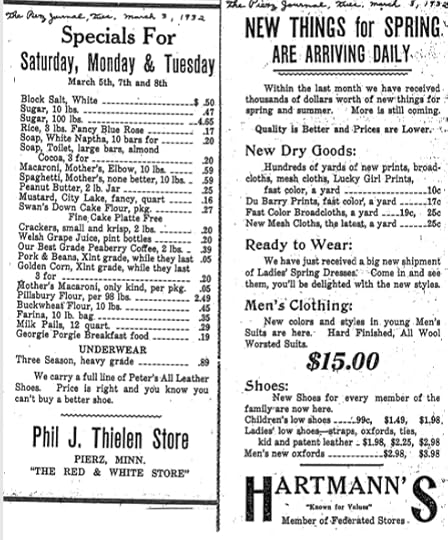

When you consider what Fundamentalist Muslim Faleh al-Maleki did with his daughter (before he murdered her), it was basically sex trafficking.
Noor al-Maleki fled Bazra, Iraq when she was 4 years old and moved to Phoenix, Arizona. Noor was on the tennis team in school and was in Yearbook. At home, Noor was supposed to obey her parents. It was her job to cook, clean and help take care of her six younger siblings. A friend reported, "And if she didn't she would be beaten."
Faleh al-Maleki arranged for his daughter, Noor, to marry his much older cousin in Iraq. Faleh had accumulated a large casino debt and traded his daughter for a dowry to pay off the debt. Noor was sent to Iraq, at age 17, while the U.S. was bombing the country. Noor admitted that the marriage was traumatic, and that during the bombings she would stand in the middle of her house, hoping to be struck by a bomb.


 In 2008, Noor was 19 years old, and was allowed to return to the U.S. Her parents insisted she abide by fundamentalist Muslim procedures. When they found a picture of her next to a boy, fully clothed (not engaging in any romantic behavior), on Myspace, her father beat her. Noor left the home and tried to kill herself in a car accident. She braked at the last minute and survived.
In 2008, Noor was 19 years old, and was allowed to return to the U.S. Her parents insisted she abide by fundamentalist Muslim procedures. When they found a picture of her next to a boy, fully clothed (not engaging in any romantic behavior), on Myspace, her father beat her. Noor left the home and tried to kill herself in a car accident. She braked at the last minute and survived.  Noor moved in with an Iraqi family friend, Amal Khalaf. She met Marwan Alebadi, a street gang member related to Amal, and he began expressing sympathy for her. Noor was hoping to pursue an education and Amal seemed to be stepping away from his criminal past. Her father, Faleh al-Maleki, didn’t feel women should work, so he would walk into her jobs and complain until she was fired. Faleh reported Noor’s car (which was in his name) stolen, and Noor was forced to move back home. Noor was beaten by both her mother and father, in their efforts to make her “a good Iraqi girl.”
Noor moved in with an Iraqi family friend, Amal Khalaf. She met Marwan Alebadi, a street gang member related to Amal, and he began expressing sympathy for her. Noor was hoping to pursue an education and Amal seemed to be stepping away from his criminal past. Her father, Faleh al-Maleki, didn’t feel women should work, so he would walk into her jobs and complain until she was fired. Faleh reported Noor’s car (which was in his name) stolen, and Noor was forced to move back home. Noor was beaten by both her mother and father, in their efforts to make her “a good Iraqi girl.”In 2009, Noor came home to find all of her clothes lying in the street. Her parents had discovered she was secretly engaged to Marwan. Noor moved back in with Amal. Faleh al-Maleki burst into the home to take Noor back home once again. But the police were called and Faleh was removed from the home. He threatened “bad things will happen.” Noor’s mother, Sahen, told Noor she keeps a voodoo doll she punishes, representing Noor.

 Faleh al-Maleki found Amal and Noor at the welfare office and waited for them outside. Amal had locked her keys in the car so she called Marwan to bring another set. When Amal and Noor step into the street, Faleh al-Maleki accelerated and drove his vehicle into both women. He had to swerve to run over his daughter. When the police tell Noor’s mother, Sahen, that Noor was dying, Sahen said, “Good.” Sahen further remarks that if she didn’t die they may send someone to finish the job. Noor was placed under 24-hour police protection. Sahen prohibited Marwan from visiting her daughter. Marwan does manage to get a couple visits through empathetic police officers.
Faleh al-Maleki found Amal and Noor at the welfare office and waited for them outside. Amal had locked her keys in the car so she called Marwan to bring another set. When Amal and Noor step into the street, Faleh al-Maleki accelerated and drove his vehicle into both women. He had to swerve to run over his daughter. When the police tell Noor’s mother, Sahen, that Noor was dying, Sahen said, “Good.” Sahen further remarks that if she didn’t die they may send someone to finish the job. Noor was placed under 24-hour police protection. Sahen prohibited Marwan from visiting her daughter. Marwan does manage to get a couple visits through empathetic police officers. Faleh al-Maleki told police, “If a small part of your house starts on fire, you must put that fire out before it burns down the whole house.” A recorded conversation between Noor’s parents revealed a discussion over how they should have taken more time killing their daughter.
On November 2, 2009, Noor al-Maleki died in the hospital. Faleh al-Maleki was sentenced to 37 years in prison. Faleh’s argument was that he killed his daughter to protect the family’s honor. I really dislike the term “honor killings” because there is no honor in killing another person because you felt embarrassed.
 Victims of “honor killings” in the U.S.
Victims of “honor killings” in the U.S.It’s estimated that 5,000 honor killings occur each year globally, with most occurring in the Middle East, North Africa and South Asia.
A weird aside related to this case: Marwan deteriorated back into crime after Noor’s death. He has been incarcerated and recently was arrested after one of the worst escape attempts ever.
Officers in Peoria, Arizona approached Marwan Al Ebadi, 28, and Salma Hourien, 29, at a gas station at 6:10 p.m. February 16, 2018, while investigating a possible shoplifting, and they took off running.
 Trying to elude pursuing cops, the couple hopped a nearby fence. The fence surrounded a clearly marked Peoria Police Department station. Marwan and his new woman friend ended up in a secure parking lot where officers were conducting a training exercise.
Trying to elude pursuing cops, the couple hopped a nearby fence. The fence surrounded a clearly marked Peoria Police Department station. Marwan and his new woman friend ended up in a secure parking lot where officers were conducting a training exercise.Thanks for listening,
Frank April 11, 2019. Frank will be providing an all-day training to licensed law enforcement officers on Addressing Mental Illness Effectively from 8:00-4:30 p.m. at Central Lakes College sponsored by the Criminal Justice program at CLC.Frank will be speaking on The I-94 Murders at the Ortonville and Graceville Public libraries on Saturday, April 13, 2019. Frank will speak at the Graceville Public Library at 10:30 a.m. located at 415 Studdart Ave, Graceville, Minnesota. Frank will then speak at the Ortonville Public Library at 2:00 p.m., located at 412 2nd St NW, Ortonville, Minnesota.May 9, 2019. Frank will be providing an all-day training to licensed law enforcement officers on Addressing Mental Illness Effectively from 8:00-4:30 p.m. at Central Lakes College sponsored by the Criminal Justice program at CLC.May 24, 2019, Frank will be speaking at The Center in Brainerd on The I-94 Murders and writing True Crime mysteries in Minnesota. The presentation is open to the public. The Center is located at 803 Kingwood Street, in Brainerd, Minnesota.
From Weber's Tires and Gas to Red's Auto and Bait. I had to include the 1932 Hartmann's ad which promises "thousands of dollars of new things."




Published on March 26, 2019 11:33
March 18, 2019
Unsolved Central Minnesota Crimes
 Jodi Huisentruit Born
Jodi Huisentruit BornJodi Sue Huisentruit
June 5, 1968
Long Prairie, Minnesota, U.S.
Disappeared
June 27, 1995 (aged 27)
Mason City, Iowa, U.S.
Died
declared legally dead May 2001
Education
St. Cloud State University
Jodi Huisentruit was raised in Long Prairie, Minnesota, and led her golf team to two state championships. Jodi became the anchor of KIMT television station in Iowa. Her producers spoke to her at 4:10 a.m. that morning. She was just leaving for work. Jodi missed her news show on the morning of June 27, 1995.
When police went to her home they found her shoe near her car and drag marks away from her car. Police found her red high heels, blow dryer, hair spray and earrings strewn across the lot. Her bent car key lay on the ground near the car, and police believe she was unlocking her car door when she was taken. An unidentified partial palm print was found on her car, but there was no other substantial evidence at the scene.
 Her sister described her as “too trusting. Too personable.” Several neighbors heard a scream the morning she disappeared, but didn’t call police. In addition, a white van was seen in the neighborhood. The car was given back to the family within 2 months after her disappearance. (They now suggest this was too early, since it was the only crime scene they had.)
Her sister described her as “too trusting. Too personable.” Several neighbors heard a scream the morning she disappeared, but didn’t call police. In addition, a white van was seen in the neighborhood. The car was given back to the family within 2 months after her disappearance. (They now suggest this was too early, since it was the only crime scene they had.)  John Vansice was the last person known to have seen her. John was recently divorced and had resided in the same apartment complex. John had strong feelings for her, which were not necessarily reciprocated. He had been required to have a breathalyzer in his vehicle prior to meeting Jodi, due to drunk driving arrests. Jodi described John as a father figure, although friends said he wanted more. John named his boat “Jodi” before her disappearance. A man had offered Jodi a car, which friends thought would have amped up John’s jealousy. John describes himself as someone who was always interested in her best interests and considered her a good friend. John and Jodi had spent the previous day together at a golf tournament. John passed a polygraph examination indicating he wasn’t involved in her disappearance.
John Vansice was the last person known to have seen her. John was recently divorced and had resided in the same apartment complex. John had strong feelings for her, which were not necessarily reciprocated. He had been required to have a breathalyzer in his vehicle prior to meeting Jodi, due to drunk driving arrests. Jodi described John as a father figure, although friends said he wanted more. John named his boat “Jodi” before her disappearance. A man had offered Jodi a car, which friends thought would have amped up John’s jealousy. John describes himself as someone who was always interested in her best interests and considered her a good friend. John and Jodi had spent the previous day together at a golf tournament. John passed a polygraph examination indicating he wasn’t involved in her disappearance. Tony Jackson was a serial rapist in Minneapolis. Each case involved stalking. Tony was living in Mason City, Iowa, two blocks away from Jodi when she disappeared. Jackson was once a star athlete at Waldorf College in Iowa. He was kicked out of the school because of his temper. He then expressed an interest of returning to college and becoming a news anchor. His ex-girlfriend, a white woman who looked very similar to Jodi, indicated she broke up with Tony 5 days before Jodi disappeared. A former cellmate of Jackson said he bragged about abducting and killing a news anchor. Jodi had complained of getting prank phone calls and expressed concern of being stalked. Tony had stalked his rape victims.
On May 14, 2001 Jodi Huisentruit was declared legally dead. Her body has never been recovered.
 Two years after Jodi’s disappeared, Tony committed violent rapes. On May 4, 1997, E.R. was alone in the home she shared with her parents when a man knocked on the door and asked if he could use the telephone. E.R. let him come in. He was a tall African American with short hair. He wore a polo shirt and a blue fanny pack with the words "St. Paul" on it.
Two years after Jodi’s disappeared, Tony committed violent rapes. On May 4, 1997, E.R. was alone in the home she shared with her parents when a man knocked on the door and asked if he could use the telephone. E.R. let him come in. He was a tall African American with short hair. He wore a polo shirt and a blue fanny pack with the words "St. Paul" on it.
Once in the house, the man put a gun to E.R.'s head and told her not to scream or he would kill her. When she said her parents would return soon, the man responded that he would kill them too. The man took E.R. to a bedroom where he put a sheet in her mouth and handcuffed her hands behind her back. He rolled her onto her back, put a blanket over her head and had vaginal intercourse with her two or three times. During his assault, the man repeatedly told E.R. to shut up or he would kill her. Tony Jackson’s thumbprint was at the scene and a rape kit indicated his DNA was present also.
Jackson was driving at 3:30 a.m. on May 19, 1997 with his headlights off when the police stopped him. They searched his car and found duct tape, and a blue fanny pack with the words "St. Paul" on it. In the pack was a set of handcuff keys.
A tall, fit African-American male entered A.S.'s home on May 22, 1997, and raped her vaginally, orally, and anally. Although the man blindfolded A.S. before he assaulted her, she briefly saw him. She thought he was a man named “Tony” who worked at a newly opened restaurant in the area. Later that day, the police arrested Jackson, a tall, fit African-American male with short hair. Tony Jackson’s fingerprint was found on her door and his DNA was present. A forensic scientist testified that the likelihood it could have been anyone other than Tony Jackson was less than one in a billion. Jackson denied both incidents. He was sentenced to 15 years in prison. I give both victims the utmost respect for surviving these attacks and testifying against him.
I wish the families only the best and I pray that someday they will find peace.
Information was removed from this blog, as a theory was released related to the homicide of an individual from central Minnesota. It was requested the information be removed due to its significance to the ongoing investigation.
On Monday, March 25, 2019, at 7:10 am, I will be interviewed on WYRQ radio at 92.1 FM by Al Windsperger about writing True Crime mysteries in central and northern Minnesota.
Thanks for listening,
Frank
I recorded this song with my brothers and sisters, and Nicolette and I danced to this song on the day she married Branden.

 St. Patrick's at the Old Brickhouse
St. Patrick's at the Old Brickhouse  Frank with the LitWits Book Club in Elk River
Frank with the LitWits Book Club in Elk River  The MN melt begins!
The MN melt begins! 



Published on March 18, 2019 14:02
March 7, 2019
Sex Trafficking and the NFL
March 18, 2019, at 6:00 p.m., Frank will be speaking to the “LitWits” Elk River book club (the literary experts from Zimmerman Elementary school) on Murder Book and The I-94 Murders.  Frank at Alexandria
Frank at Alexandria  Sex Trafficking and the NFL
Sex Trafficking and the NFL
I had the opportunity to listen to John Choi, Ramsey County attorney, speak on sex trafficking in Minneapolis this week. Here are some statistics for Minnesota: - Sex trafficking 94% female
- Sex trafficking 94% female
- 41% under the age of 18 (Consider this: If a man has sex with 2 prostitutes, it’s likely 1 was underage.)
- Average age of entry is 13. (This means that your average age that a sex worker was first paid for sex was age 13.)
- The work significantly diminishes average life expectancy. (It’s the job you’re most likely to be murdered performing.) The life expectancy of sex workers is shorter than victims of any other crime. Suicide and drug overdose is common.
- In 2011, Ramsey County announced they will no longer prosecute underage sex workers. They are the victims.
- The "Taken" scenario is uncommon. The number of cases in Minnesota involving a girl being kidnapped for prostitution = 1. The media misses typical scenario.
- The vast majority are not forced into prostitution, but a pimp posing as a boyfriend talks them into it. Typically, she’s a runaway leaving home to be with a guy she met online, or at the mall. She stays at his home for a couple weeks, and he finally breaks it to her that she needs to generate some money.
- I listened to a ‘911’ call from a 17-year-old girl. In the first week her “boyfriend” had her start having sex with men to help him out financially, she was made to have sex with 30 men.
Trafficking is driven by greed, money, sex, power and control.
Never forget, it’s driven by the demand and the way we raise boys and girls - When an ad is posted online for an underage girl to be an “escort” for adult men, it’s only a matter of minutes before responses start pouring in. Backpage was making $5 million a month on sex trafficking before it was shut down.
- When an ad is posted online for an underage girl to be an “escort” for adult men, it’s only a matter of minutes before responses start pouring in. Backpage was making $5 million a month on sex trafficking before it was shut down.
- The number of women raped and assaulted in the state of Minnesota would fill Target Field 17 times.
- The state keeps giving more and more money for addressing victims of sex trafficking, which is positive, but it’s behind the ball. (It’s called Tertiary prevention. You help people after they’ve been victimized to help prevent recurrence.) We need Primary prevention, which would involve teaching people better values and to respect others.
- A positive is that hotels like the Radisson and Hilton have taken a stand by encouraging staff to report sex trafficking.
I’ve completed many psychological assessments on sex workers, and strippers are generally the most mentally damaged people I do assessments on. There is so much trauma, fear, drug abuse and eventual callousness. They can put on a temporary act, but they hate their customers, and if they could get their money another way, they would. My last words on Colin Kaepernick. First of all, I want to be clear I have nothing against the guy. I think he would like to make the world better. I knew from the onset this would end badly and would further polarize working class Americans. Here’s how the issue presented from my perspective:
My last words on Colin Kaepernick. First of all, I want to be clear I have nothing against the guy. I think he would like to make the world better. I knew from the onset this would end badly and would further polarize working class Americans. Here’s how the issue presented from my perspective:
Issue: The primary issue is a lack of justice for poor people.
Colin’s solution: Put the camera on me. I will kneel during the national anthem. This will bring attention to the problem. America will be better.
Backlash: Having family in the military, I have been on a numerous military bases in the past few years, and the vast majority of veterans feel disrespected by the NFL’s failure to pay tribute to people who risk their lives for our freedom. On a military base, everyone stands and salutes the flag when the national anthem plays, no matter what you are doing, out of respect for those who gave it all. Our military comes primarily from working class families. NFL athletes come primarily from working class families. Is there a solution to be found in creating this rift?
Result: Colin Kaepernick received greater popularity from his supporters. Donald Trump received greater popularity from his supporters complaining about the NFL. No compromise from either. Colin gets cut from the NFL because he is no longer good enough to take a team to the Super Bowl. Colin supporters suggest he was blocked from teams because of a moral issue. I would like to believe the NFL is run by men of high moral high fiber, but it isn’t. Think of all of the abusive slime balls who are allowed to continue to play in the NFL. They are allowed to play because they help teams win. Anyone who knows the NFL knows it’s about money and the prestige of winning the Super Bowl. When you no longer have the ability to take a team to the Super Bowl, you’re expendable. Colin Kaepernick has recently made a rather quiet deal with the NFL to accept $8 million dollars for his trouble. Colin’s better off. Donald Trump’s better off over this issue. Are poor people better off? I prefer efforts that actually work toward solving the problem.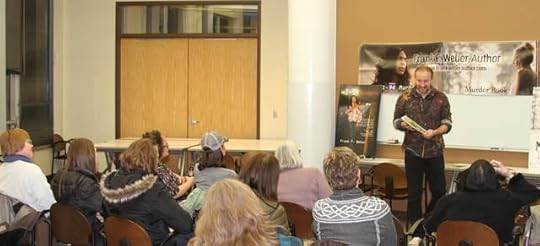 Frank speaking in Elk River My “Coldest Book Tour in the History of Earth” is winding down, although I have some book clubs and additional libraries requesting presentations. I am so thankful for the crowds I received at libraries all over the state-- even on days when it was -25. I had 80 people attend my presentation in Alexandria. Success only comes with the kindness of support of others!
Frank speaking in Elk River My “Coldest Book Tour in the History of Earth” is winding down, although I have some book clubs and additional libraries requesting presentations. I am so thankful for the crowds I received at libraries all over the state-- even on days when it was -25. I had 80 people attend my presentation in Alexandria. Success only comes with the kindness of support of others!
Thank you!
Frank

















 Frank at Alexandria
Frank at Alexandria  Sex Trafficking and the NFL
Sex Trafficking and the NFLI had the opportunity to listen to John Choi, Ramsey County attorney, speak on sex trafficking in Minneapolis this week. Here are some statistics for Minnesota:
 - Sex trafficking 94% female
- Sex trafficking 94% female- 41% under the age of 18 (Consider this: If a man has sex with 2 prostitutes, it’s likely 1 was underage.)
- Average age of entry is 13. (This means that your average age that a sex worker was first paid for sex was age 13.)
- The work significantly diminishes average life expectancy. (It’s the job you’re most likely to be murdered performing.) The life expectancy of sex workers is shorter than victims of any other crime. Suicide and drug overdose is common.
- In 2011, Ramsey County announced they will no longer prosecute underage sex workers. They are the victims.
- The "Taken" scenario is uncommon. The number of cases in Minnesota involving a girl being kidnapped for prostitution = 1. The media misses typical scenario.
- The vast majority are not forced into prostitution, but a pimp posing as a boyfriend talks them into it. Typically, she’s a runaway leaving home to be with a guy she met online, or at the mall. She stays at his home for a couple weeks, and he finally breaks it to her that she needs to generate some money.
- I listened to a ‘911’ call from a 17-year-old girl. In the first week her “boyfriend” had her start having sex with men to help him out financially, she was made to have sex with 30 men.
Trafficking is driven by greed, money, sex, power and control.
Never forget, it’s driven by the demand and the way we raise boys and girls
 - When an ad is posted online for an underage girl to be an “escort” for adult men, it’s only a matter of minutes before responses start pouring in. Backpage was making $5 million a month on sex trafficking before it was shut down.
- When an ad is posted online for an underage girl to be an “escort” for adult men, it’s only a matter of minutes before responses start pouring in. Backpage was making $5 million a month on sex trafficking before it was shut down.- The number of women raped and assaulted in the state of Minnesota would fill Target Field 17 times.
- The state keeps giving more and more money for addressing victims of sex trafficking, which is positive, but it’s behind the ball. (It’s called Tertiary prevention. You help people after they’ve been victimized to help prevent recurrence.) We need Primary prevention, which would involve teaching people better values and to respect others.
- A positive is that hotels like the Radisson and Hilton have taken a stand by encouraging staff to report sex trafficking.
I’ve completed many psychological assessments on sex workers, and strippers are generally the most mentally damaged people I do assessments on. There is so much trauma, fear, drug abuse and eventual callousness. They can put on a temporary act, but they hate their customers, and if they could get their money another way, they would.
 My last words on Colin Kaepernick. First of all, I want to be clear I have nothing against the guy. I think he would like to make the world better. I knew from the onset this would end badly and would further polarize working class Americans. Here’s how the issue presented from my perspective:
My last words on Colin Kaepernick. First of all, I want to be clear I have nothing against the guy. I think he would like to make the world better. I knew from the onset this would end badly and would further polarize working class Americans. Here’s how the issue presented from my perspective:Issue: The primary issue is a lack of justice for poor people.
Colin’s solution: Put the camera on me. I will kneel during the national anthem. This will bring attention to the problem. America will be better.
Backlash: Having family in the military, I have been on a numerous military bases in the past few years, and the vast majority of veterans feel disrespected by the NFL’s failure to pay tribute to people who risk their lives for our freedom. On a military base, everyone stands and salutes the flag when the national anthem plays, no matter what you are doing, out of respect for those who gave it all. Our military comes primarily from working class families. NFL athletes come primarily from working class families. Is there a solution to be found in creating this rift?
Result: Colin Kaepernick received greater popularity from his supporters. Donald Trump received greater popularity from his supporters complaining about the NFL. No compromise from either. Colin gets cut from the NFL because he is no longer good enough to take a team to the Super Bowl. Colin supporters suggest he was blocked from teams because of a moral issue. I would like to believe the NFL is run by men of high moral high fiber, but it isn’t. Think of all of the abusive slime balls who are allowed to continue to play in the NFL. They are allowed to play because they help teams win. Anyone who knows the NFL knows it’s about money and the prestige of winning the Super Bowl. When you no longer have the ability to take a team to the Super Bowl, you’re expendable. Colin Kaepernick has recently made a rather quiet deal with the NFL to accept $8 million dollars for his trouble. Colin’s better off. Donald Trump’s better off over this issue. Are poor people better off? I prefer efforts that actually work toward solving the problem.
 Frank speaking in Elk River My “Coldest Book Tour in the History of Earth” is winding down, although I have some book clubs and additional libraries requesting presentations. I am so thankful for the crowds I received at libraries all over the state-- even on days when it was -25. I had 80 people attend my presentation in Alexandria. Success only comes with the kindness of support of others!
Frank speaking in Elk River My “Coldest Book Tour in the History of Earth” is winding down, although I have some book clubs and additional libraries requesting presentations. I am so thankful for the crowds I received at libraries all over the state-- even on days when it was -25. I had 80 people attend my presentation in Alexandria. Success only comes with the kindness of support of others!Thank you!
Frank


















Published on March 07, 2019 11:50
February 24, 2019
R. Kraft, R. Kelly, R U Kidding?
March 4, 2019: Frank will be speaking at the Douglas County Public Library on Monday evening at 6:00 p.m. The Douglas County Public Library is located at 720 Filmore Street, Alexandria, Minnesota. 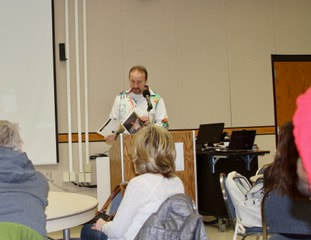 Frank speaking at South Central College in Mankato.
Frank speaking at South Central College in Mankato. 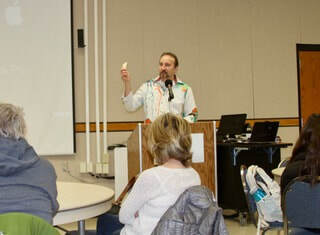
 Frank at Long Prairie Library
Frank at Long Prairie Library  Another Patriots deflated balls scandal: As part of a month-long investigation targeting a human trafficking ring, New England Patriots owner and food empire mogul Robert Kraft was charged with soliciting a prostitute. The police had tips prostitutes were lured into sex trafficking at the Orchids of Asia massage parlor in Jupiter, Florida, where Kraft was videotaped. The police had received a warrant to place hidden cameras in the parlor and body cameras were also used. The police report indicates they have Kraft on camera paying for sex from a sex worker on 2 occasions. The sex workers averaged 1500 clients a year (5 a day). Kraft is worth $6.6 billion, and his spokesperson “categorically denies” that Kraft was involved in illegal activity. Remember Kraft saying after the Super Bowl, “The trick is that you have to attract the type of people who fit your culture.” What is that culture Robert?
Another Patriots deflated balls scandal: As part of a month-long investigation targeting a human trafficking ring, New England Patriots owner and food empire mogul Robert Kraft was charged with soliciting a prostitute. The police had tips prostitutes were lured into sex trafficking at the Orchids of Asia massage parlor in Jupiter, Florida, where Kraft was videotaped. The police had received a warrant to place hidden cameras in the parlor and body cameras were also used. The police report indicates they have Kraft on camera paying for sex from a sex worker on 2 occasions. The sex workers averaged 1500 clients a year (5 a day). Kraft is worth $6.6 billion, and his spokesperson “categorically denies” that Kraft was involved in illegal activity. Remember Kraft saying after the Super Bowl, “The trick is that you have to attract the type of people who fit your culture.” What is that culture Robert?  Robert Kraft and wife, Ricki Lander Robert’s wife of 48 years, Myra, died of cancer in 2011, and many suggest he has been different since. Out of respect for her, I didn’t include her picture in this article. He also has unlimited access to mental health resources which is a luxury few have in the U.S. Because if you can make excuses for him, you can make excuses for anybody. For example, R. Kelly was raised in poverty in inner-city Chicago with no father involved, and I can’t excuse his behavior either.
Robert Kraft and wife, Ricki Lander Robert’s wife of 48 years, Myra, died of cancer in 2011, and many suggest he has been different since. Out of respect for her, I didn’t include her picture in this article. He also has unlimited access to mental health resources which is a luxury few have in the U.S. Because if you can make excuses for him, you can make excuses for anybody. For example, R. Kelly was raised in poverty in inner-city Chicago with no father involved, and I can’t excuse his behavior either.
Speaking of Roberts, R. Kelly shared the headlines with R. Kraft by being charged with 10 counts of Aggravated Criminal Sexual Abuse. R. Kelly was previously acquitted of child pornography charges in 2008, after it is reported he used a 13-year-old girl in a sex video. His new charges suggest a 14-year-old was used in a sex video.
There is a new organization called Fight the New Drug, which is attempting to fight porn use and sex trafficking, that is worth looking up. R. Kelly's ex-wife Andrea "Drea" Kelly and daughter Abi (whose real name is Joann Kelly) got emotional in explaining why they might feel conflicted over the onslaught of allegations leveled against R. Kelly. Andrea, who was married to R. Kelly from 1996 to 2009, shared, "It's devastating at heart, because I wear two hats. I sit here not only as a survivor, but also as the mother of his [three] children."
R. Kelly's ex-wife Andrea "Drea" Kelly and daughter Abi (whose real name is Joann Kelly) got emotional in explaining why they might feel conflicted over the onslaught of allegations leveled against R. Kelly. Andrea, who was married to R. Kelly from 1996 to 2009, shared, "It's devastating at heart, because I wear two hats. I sit here not only as a survivor, but also as the mother of his [three] children."  In all fairness, R. Kraft and R. Kelly have been charged, but neither has been convicted of any sexual crimes at this point. My concern is that these charges may reflect the genuine disrespect wealthy people have for the lives of those who struggle. Prior to 1940, only the richest 7% of Americans paid a federal tax. Today, most of our wealthiest citizens seem to believe they have no responsibility to help out others. After realizing that all of the various millionaires and billionaires who ran for president in 2016 paid a significantly lower % in taxes than I do, I’ve come to believe that a flat tax of 10% for everyone would be the fairest solution. No tax crap at the end of the year. Everyone pays the same. No more Jared Kushner characters who make over $300 million without paying federal taxes. Sorry for that rant--enough said…
In all fairness, R. Kraft and R. Kelly have been charged, but neither has been convicted of any sexual crimes at this point. My concern is that these charges may reflect the genuine disrespect wealthy people have for the lives of those who struggle. Prior to 1940, only the richest 7% of Americans paid a federal tax. Today, most of our wealthiest citizens seem to believe they have no responsibility to help out others. After realizing that all of the various millionaires and billionaires who ran for president in 2016 paid a significantly lower % in taxes than I do, I’ve come to believe that a flat tax of 10% for everyone would be the fairest solution. No tax crap at the end of the year. Everyone pays the same. No more Jared Kushner characters who make over $300 million without paying federal taxes. Sorry for that rant--enough said…  The last blog, which featured the song “Fooled Around and Fell in Love,” created some great Facebook discussion on the “mixed tape.” Remember when you used to make a mixed tape, and give it to someone you cared about? I remember my recording of Sister Golden Hair had the DJ saying, “1, 2, 3, 4, 1” at the end. You had to hope the station would play the song to the end and the DJ wouldn’t talk. I’m taking this next comment from Annette—because it is so true. If you taped it on cassette, not through a stereo system, you ran the risk of someone yelling or a dog barking in the background, and it was forever on your recording. I still like the idea of sharing a mixed recording. As a teen I remember thinking, “You know that song—that’s exactly how I feel,” when I couldn’t better explain my emotions. I also find it interesting that every generation, later on, listens to the music they listened to during their adolescence—reflecting the strong emotional impact of our teens.
The last blog, which featured the song “Fooled Around and Fell in Love,” created some great Facebook discussion on the “mixed tape.” Remember when you used to make a mixed tape, and give it to someone you cared about? I remember my recording of Sister Golden Hair had the DJ saying, “1, 2, 3, 4, 1” at the end. You had to hope the station would play the song to the end and the DJ wouldn’t talk. I’m taking this next comment from Annette—because it is so true. If you taped it on cassette, not through a stereo system, you ran the risk of someone yelling or a dog barking in the background, and it was forever on your recording. I still like the idea of sharing a mixed recording. As a teen I remember thinking, “You know that song—that’s exactly how I feel,” when I couldn’t better explain my emotions. I also find it interesting that every generation, later on, listens to the music they listened to during their adolescence—reflecting the strong emotional impact of our teens.
One of my biggest mistakes when I was younger was not understanding that problems are finite. They have a beginning and an end. Instead I’d get wrapped up in the overwhelming impact of being in the middle of them. I’m not sure if that naivety made me more, or less, likeable. Regardless, I can smile at it now, which makes me happier. I recorded this song when I was 14 years old.
Thanks for listening,
Frank The Deals visit Minnesota




















 Frank speaking at South Central College in Mankato.
Frank speaking at South Central College in Mankato. 
 Frank at Long Prairie Library
Frank at Long Prairie Library  Another Patriots deflated balls scandal: As part of a month-long investigation targeting a human trafficking ring, New England Patriots owner and food empire mogul Robert Kraft was charged with soliciting a prostitute. The police had tips prostitutes were lured into sex trafficking at the Orchids of Asia massage parlor in Jupiter, Florida, where Kraft was videotaped. The police had received a warrant to place hidden cameras in the parlor and body cameras were also used. The police report indicates they have Kraft on camera paying for sex from a sex worker on 2 occasions. The sex workers averaged 1500 clients a year (5 a day). Kraft is worth $6.6 billion, and his spokesperson “categorically denies” that Kraft was involved in illegal activity. Remember Kraft saying after the Super Bowl, “The trick is that you have to attract the type of people who fit your culture.” What is that culture Robert?
Another Patriots deflated balls scandal: As part of a month-long investigation targeting a human trafficking ring, New England Patriots owner and food empire mogul Robert Kraft was charged with soliciting a prostitute. The police had tips prostitutes were lured into sex trafficking at the Orchids of Asia massage parlor in Jupiter, Florida, where Kraft was videotaped. The police had received a warrant to place hidden cameras in the parlor and body cameras were also used. The police report indicates they have Kraft on camera paying for sex from a sex worker on 2 occasions. The sex workers averaged 1500 clients a year (5 a day). Kraft is worth $6.6 billion, and his spokesperson “categorically denies” that Kraft was involved in illegal activity. Remember Kraft saying after the Super Bowl, “The trick is that you have to attract the type of people who fit your culture.” What is that culture Robert?  Robert Kraft and wife, Ricki Lander Robert’s wife of 48 years, Myra, died of cancer in 2011, and many suggest he has been different since. Out of respect for her, I didn’t include her picture in this article. He also has unlimited access to mental health resources which is a luxury few have in the U.S. Because if you can make excuses for him, you can make excuses for anybody. For example, R. Kelly was raised in poverty in inner-city Chicago with no father involved, and I can’t excuse his behavior either.
Robert Kraft and wife, Ricki Lander Robert’s wife of 48 years, Myra, died of cancer in 2011, and many suggest he has been different since. Out of respect for her, I didn’t include her picture in this article. He also has unlimited access to mental health resources which is a luxury few have in the U.S. Because if you can make excuses for him, you can make excuses for anybody. For example, R. Kelly was raised in poverty in inner-city Chicago with no father involved, and I can’t excuse his behavior either.Speaking of Roberts, R. Kelly shared the headlines with R. Kraft by being charged with 10 counts of Aggravated Criminal Sexual Abuse. R. Kelly was previously acquitted of child pornography charges in 2008, after it is reported he used a 13-year-old girl in a sex video. His new charges suggest a 14-year-old was used in a sex video.
There is a new organization called Fight the New Drug, which is attempting to fight porn use and sex trafficking, that is worth looking up.
 R. Kelly's ex-wife Andrea "Drea" Kelly and daughter Abi (whose real name is Joann Kelly) got emotional in explaining why they might feel conflicted over the onslaught of allegations leveled against R. Kelly. Andrea, who was married to R. Kelly from 1996 to 2009, shared, "It's devastating at heart, because I wear two hats. I sit here not only as a survivor, but also as the mother of his [three] children."
R. Kelly's ex-wife Andrea "Drea" Kelly and daughter Abi (whose real name is Joann Kelly) got emotional in explaining why they might feel conflicted over the onslaught of allegations leveled against R. Kelly. Andrea, who was married to R. Kelly from 1996 to 2009, shared, "It's devastating at heart, because I wear two hats. I sit here not only as a survivor, but also as the mother of his [three] children."  In all fairness, R. Kraft and R. Kelly have been charged, but neither has been convicted of any sexual crimes at this point. My concern is that these charges may reflect the genuine disrespect wealthy people have for the lives of those who struggle. Prior to 1940, only the richest 7% of Americans paid a federal tax. Today, most of our wealthiest citizens seem to believe they have no responsibility to help out others. After realizing that all of the various millionaires and billionaires who ran for president in 2016 paid a significantly lower % in taxes than I do, I’ve come to believe that a flat tax of 10% for everyone would be the fairest solution. No tax crap at the end of the year. Everyone pays the same. No more Jared Kushner characters who make over $300 million without paying federal taxes. Sorry for that rant--enough said…
In all fairness, R. Kraft and R. Kelly have been charged, but neither has been convicted of any sexual crimes at this point. My concern is that these charges may reflect the genuine disrespect wealthy people have for the lives of those who struggle. Prior to 1940, only the richest 7% of Americans paid a federal tax. Today, most of our wealthiest citizens seem to believe they have no responsibility to help out others. After realizing that all of the various millionaires and billionaires who ran for president in 2016 paid a significantly lower % in taxes than I do, I’ve come to believe that a flat tax of 10% for everyone would be the fairest solution. No tax crap at the end of the year. Everyone pays the same. No more Jared Kushner characters who make over $300 million without paying federal taxes. Sorry for that rant--enough said…  The last blog, which featured the song “Fooled Around and Fell in Love,” created some great Facebook discussion on the “mixed tape.” Remember when you used to make a mixed tape, and give it to someone you cared about? I remember my recording of Sister Golden Hair had the DJ saying, “1, 2, 3, 4, 1” at the end. You had to hope the station would play the song to the end and the DJ wouldn’t talk. I’m taking this next comment from Annette—because it is so true. If you taped it on cassette, not through a stereo system, you ran the risk of someone yelling or a dog barking in the background, and it was forever on your recording. I still like the idea of sharing a mixed recording. As a teen I remember thinking, “You know that song—that’s exactly how I feel,” when I couldn’t better explain my emotions. I also find it interesting that every generation, later on, listens to the music they listened to during their adolescence—reflecting the strong emotional impact of our teens.
The last blog, which featured the song “Fooled Around and Fell in Love,” created some great Facebook discussion on the “mixed tape.” Remember when you used to make a mixed tape, and give it to someone you cared about? I remember my recording of Sister Golden Hair had the DJ saying, “1, 2, 3, 4, 1” at the end. You had to hope the station would play the song to the end and the DJ wouldn’t talk. I’m taking this next comment from Annette—because it is so true. If you taped it on cassette, not through a stereo system, you ran the risk of someone yelling or a dog barking in the background, and it was forever on your recording. I still like the idea of sharing a mixed recording. As a teen I remember thinking, “You know that song—that’s exactly how I feel,” when I couldn’t better explain my emotions. I also find it interesting that every generation, later on, listens to the music they listened to during their adolescence—reflecting the strong emotional impact of our teens. One of my biggest mistakes when I was younger was not understanding that problems are finite. They have a beginning and an end. Instead I’d get wrapped up in the overwhelming impact of being in the middle of them. I’m not sure if that naivety made me more, or less, likeable. Regardless, I can smile at it now, which makes me happier. I recorded this song when I was 14 years old.
Thanks for listening,
Frank The Deals visit Minnesota




















Published on February 24, 2019 10:30
February 18, 2019
Fooled Around and Fell in Love
The Paper Mill Creek Saloon bartender, Jenny Villarin, was a person who always remembered to call on your birthday. Jenny was a hard worker who cleaned houses for extra money, and was beautiful. Blues musician Elvin Bishop wrote his number one hit, “Fooled Around and Fell in Love,” about her. Elvin and Jenny had a daughter, Selena, together. As a result of Elvin’s constant touring, the relationship didn’t make it. 
 Jenny Villarin
Jenny Villarin
On August 3, 2000, Jenny and her significant other, James Gamble, were shot to death in Jenny’s apartment. Her 22-year-old daughter, Selena Bishop, was missing.
Jenny was killed simply for meeting her daughter’s boyfriend face to face, and James was killed simply for being with Jenny that night. James was described as a man who went out of his way to do kind things for his mother.
Jenny’s daughter, Selena, had started dating a man she referred to as Jordan. Jordan was supposedly about to inherit $100,000. Selena had agreed to help him out by putting it into her bank account. Jenny was bothered that Selena never brought her boyfriend around, so she made an excuse to go to Selena’s house while he was there. Selena Bishop
Selena Bishop
Investigators looking for Selena realized that “Jordan” was actually Glen “Taylor” Helzer. Taylor and his brother Justin were young adult recruiters for the Mormon Church.
Vicki Sexton, a bank manager, was watching the news when she saw her clients, Ivan Stineman, 85, and his wife, Annette's, 78, van was found in a dangerous part of Oakland. A customer, Dawn Godman, had wheeled herself to Vicki’s desk, and had checks for $100,000 from the Stinemans that were supposed to be deposited in Selena Bishop’s checking account. Vicki didn’t authorize the transaction, as it seemed to be too questionable. Ivan and Annette Stineman were missing.
Police raided the Helzer home at 4:45 am. They find Taylor Helzer, Justin Helzer and Dawn Godman. Taylor manages to get away and a chase ensues. Taylor is jumping fences and running through houses. He manages to get a woman to let him in. He cut his hair, found a change of clothes, and headed on his way. The woman called the police and at 11:48 am police trap him as he exits a yard and arrest him. In the Helzer home, they find Rohypnal (the date rape drug), handcuffs, duct tape and guns.
A duffel bag is found 40 miles away floating on the Sacramento river. A fisherman opens it, and finds body parts. The police search and find 9 duffel bags containing parts from Ivan and Annette Stinemen and Selena Bishop. They had even cut Selena’s tattoo off, to make it more difficult to identify her body.
Taylor and Justin Helzer kidnapped the Stinemans, had them write checks, and killed them. Taylor developed a relationship with Selena Bishop, with the plan of transferring their stolen money into her account. Taylor and Justin Helzer
Taylor and Justin Helzer
What was the crazy plan based on? Taylor believed he was a prophet of God. He had planned on taking in Brazilian orphans and training them to be his army when he went to Salt Lake City to slaughter Mormon leaders. Taylor thought they would take over the Mormon Church. In order to carry out his mission he needed millions of dollars. Taylor referred to his group (including his brother Justin and Dawn Godman) as the “Children of Thunder.” Dawn Godman pled guilty to murder and received a 38 year sentence. Taylor Helzer pled guilty to all charges. Justin Helzer pled not guilty due to insanity, but was found guilty.
Selena Bishop was a naïve 22 year old who trusted Taylor. Taylor offered to give Selena a massage, and had Justin come in and beat her with a hammer. Selena’s mother, Jenny, was killed because she had seen Taylor’s face. Her partner, James Gamble, died for being with Jenny on that night. Ivan and Annette Stineman died like the others, innocent victims of terrible self-centered people.
Justin Helzer committed suicide in 2013 while on death row. The group leader, his brother Glenn "Taylor" Helzer, is awaiting execution. Dawn Godman was sentenced to a term of 38 years to life in prison.
God Bless the decent people lost:
Selina Bishop 1977-2000
Jennifer Villarin 1955-2000
James Gamble 1946-2000
Annette Stineman 1922-2000
Ivan Stineman 1915-2000 By the way, I don’t write about Ted Bundy because I feel he’s been glorified too much by the media. He wasn’t a genius. He dropped out of college and his efforts to defend himself got him convicted. Bundy was slimeball who couldn’t handle his victims living, so he typically had sex with them after they were dead. I see no reason to give him credit for anything, other than being an argument by some for maintaining the death penalty.
There are terrible people who take advantage of vulnerable people, so it’s on us to take time to appreciate and help others when we have the opportunity.
Thanks for listening,
Frank

 Jenny Villarin
Jenny VillarinOn August 3, 2000, Jenny and her significant other, James Gamble, were shot to death in Jenny’s apartment. Her 22-year-old daughter, Selena Bishop, was missing.
Jenny was killed simply for meeting her daughter’s boyfriend face to face, and James was killed simply for being with Jenny that night. James was described as a man who went out of his way to do kind things for his mother.
Jenny’s daughter, Selena, had started dating a man she referred to as Jordan. Jordan was supposedly about to inherit $100,000. Selena had agreed to help him out by putting it into her bank account. Jenny was bothered that Selena never brought her boyfriend around, so she made an excuse to go to Selena’s house while he was there.
 Selena Bishop
Selena BishopInvestigators looking for Selena realized that “Jordan” was actually Glen “Taylor” Helzer. Taylor and his brother Justin were young adult recruiters for the Mormon Church.
Vicki Sexton, a bank manager, was watching the news when she saw her clients, Ivan Stineman, 85, and his wife, Annette's, 78, van was found in a dangerous part of Oakland. A customer, Dawn Godman, had wheeled herself to Vicki’s desk, and had checks for $100,000 from the Stinemans that were supposed to be deposited in Selena Bishop’s checking account. Vicki didn’t authorize the transaction, as it seemed to be too questionable. Ivan and Annette Stineman were missing.
Police raided the Helzer home at 4:45 am. They find Taylor Helzer, Justin Helzer and Dawn Godman. Taylor manages to get away and a chase ensues. Taylor is jumping fences and running through houses. He manages to get a woman to let him in. He cut his hair, found a change of clothes, and headed on his way. The woman called the police and at 11:48 am police trap him as he exits a yard and arrest him. In the Helzer home, they find Rohypnal (the date rape drug), handcuffs, duct tape and guns.
A duffel bag is found 40 miles away floating on the Sacramento river. A fisherman opens it, and finds body parts. The police search and find 9 duffel bags containing parts from Ivan and Annette Stinemen and Selena Bishop. They had even cut Selena’s tattoo off, to make it more difficult to identify her body.
Taylor and Justin Helzer kidnapped the Stinemans, had them write checks, and killed them. Taylor developed a relationship with Selena Bishop, with the plan of transferring their stolen money into her account.
 Taylor and Justin Helzer
Taylor and Justin HelzerWhat was the crazy plan based on? Taylor believed he was a prophet of God. He had planned on taking in Brazilian orphans and training them to be his army when he went to Salt Lake City to slaughter Mormon leaders. Taylor thought they would take over the Mormon Church. In order to carry out his mission he needed millions of dollars. Taylor referred to his group (including his brother Justin and Dawn Godman) as the “Children of Thunder.” Dawn Godman pled guilty to murder and received a 38 year sentence. Taylor Helzer pled guilty to all charges. Justin Helzer pled not guilty due to insanity, but was found guilty.
Selena Bishop was a naïve 22 year old who trusted Taylor. Taylor offered to give Selena a massage, and had Justin come in and beat her with a hammer. Selena’s mother, Jenny, was killed because she had seen Taylor’s face. Her partner, James Gamble, died for being with Jenny on that night. Ivan and Annette Stineman died like the others, innocent victims of terrible self-centered people.
Justin Helzer committed suicide in 2013 while on death row. The group leader, his brother Glenn "Taylor" Helzer, is awaiting execution. Dawn Godman was sentenced to a term of 38 years to life in prison.
God Bless the decent people lost:
Selina Bishop 1977-2000
Jennifer Villarin 1955-2000
James Gamble 1946-2000
Annette Stineman 1922-2000
Ivan Stineman 1915-2000 By the way, I don’t write about Ted Bundy because I feel he’s been glorified too much by the media. He wasn’t a genius. He dropped out of college and his efforts to defend himself got him convicted. Bundy was slimeball who couldn’t handle his victims living, so he typically had sex with them after they were dead. I see no reason to give him credit for anything, other than being an argument by some for maintaining the death penalty.
There are terrible people who take advantage of vulnerable people, so it’s on us to take time to appreciate and help others when we have the opportunity.
Thanks for listening,
Frank
Published on February 18, 2019 10:54
February 12, 2019
The New Jim Crow
 Michelle Alexander looks at how the “War on Drugs” has been used over and over by politicians for votes resulting in a costly and unresolved problem.
Michelle Alexander looks at how the “War on Drugs” has been used over and over by politicians for votes resulting in a costly and unresolved problem. The Old Jim Crow
After slavery was abolished, the United States went through the reconstruction period which attempted to afford African Americans equal rights. This was followed by a backlash of “Jim Crow laws.” The Ku Klux Klan was started by a group of confederate soldiers in Pulaski, Tennessee.
Who was Jim Crow?
Thomas Rice, a white man born in New York City in 1808, painted his face black (black face) and did a song and dance called “Jump, Jim Crow” mocking an African American slave.
Following the assassination of Abraham Lincoln, laws were put into place which allowed plantation owners to return African Americans into slavery with the support of the new President, Andrew Johnson. For example: You could no longer make someone a slave on the basis of race, but you could arrest someone for being unemployed (vagrancy) and make them work off their debt. African Americans were frequently arrested and made to once again perform slave labor.
Segregated waiting rooms, water fountains, restrooms, building entrances, elevators, cemeteries, and even amusement-park cashier windows, became common. Laws forbade African Americans from living in white neighborhoods. Segregation was enforced for public pools, phone booths, hospitals, asylums, jails and residential homes for the elderly. Marriage and cohabitation between whites and blacks was strictly forbidden in most southern states.
Richard Nixon began the “War on Drugs” in his 1968 presidential campaign. Nixon aide, John Erlichman, was quoted in Harpers stating: “You want to know what this was really all about?” he asked with the bluntness of a man who, after public disgrace following Watergate and a stretch in federal prison, had little left to protect. “The Nixon campaign in 1968, and the Nixon White House after that, had two enemies: the antiwar left and black people. You understand what I’m saying? We knew we couldn’t make it illegal to be either against the war or black, but by getting the public to associate the hippies with marijuana and blacks with heroin, and then criminalizing both heavily, we could disrupt those communities. We could arrest their leaders, raid their homes, break up their meetings, and vilify them night after night on the evening news. Did we know we were lying about the drugs? Of course we did.”
And president after president, including Reagan, Bush, Clinton, Bush, Obama and Trump have continued the process with each committing more and money to the “war.” We have equipped our inner-city police departments with military equipment and are incarcerating people for drug crimes in record numbers, despite the fact that drug use peaked in the U.S. about 40 years ago. In 1986, the Special Weapons and Tactics team (SWAT) was called in Minneapolis 35 times for raids. In 1996, when drug use was actually lower, the SWAT team was called in 750 times. They are given “No knock” warrants which allow them to burst into homes and drop flash grenades. I understand that at times this is warranted, but the frequency is difficult to explain.
In 2003, in Harlem, 57-year-old, Alberta Spuill died of a heart attack when a SWAT team burst into her home and dropped flash grenades. Alberta was a church going woman with no criminal history. The raid was based on information provided by an addict who had claimed he had used drugs in the home. They later determined he was lying. The addict was in jail on the day he claimed to have used drugs in the home, and the man he supposedly bought the drugs from was in jail at the time the raid occurred.
In 2016, Edgar Camacho-Alvarado, 23, was shot and killed in Albuquerque, New Mexico, when police raided the wrong home. The young man was not actually guilty of any crime, nor did he pose a threat to officers, and he never even attempted to interfere with their investigation. He was simply at the wrong place at the wrong time, working to fix the engine in his truck in the driveway in front of his home. Alberto was to be married the following week.
 The 14th Amendment states: “nor shall any state deprive any person of life, liberty, or property, without due process of law; nor deny to any person within its jurisdiction the equal protection of the laws.” Consider this when you read the following paragraphs:
The 14th Amendment states: “nor shall any state deprive any person of life, liberty, or property, without due process of law; nor deny to any person within its jurisdiction the equal protection of the laws.” Consider this when you read the following paragraphs:Drug raids are given considerable latitude. I blogged last time on how police officers couldn’t raid a home because the neighbor who heard the woman scream wasn’t sure if the scream occurred in the home or outside. The woman ended up being raped and murdered in her home. Ironically, if the neighbor would have said he suspected her of using drugs in her home, they could have raided the home.
While police can’t search without a warrant, they can haul you to jail for a crime that would only require a fine payment, if you refuse a search. For example: If you were pulled over for failing to use a turn signal, and refused to allow a search of your car, you could be hauled to jail for the traffic violation.
If the officer didn’t want to hassle with ticket, you can be searched for meeting the profile of a drug dealer. This may seem reasonable until you see that the profile includes everybody. For example: It includes “acting guilty” or “acting innocent,” “driving a nice car” or “driving a junk car,” and my favorite, “traveling alone” or “travelling with someone.”
One of the most common complaints occurs when a woman borrows her car to a man. It may be a neighbor or a man she’s dating. He stops and picks up a drug, without her awareness, and the police arrest him. The police can keep her car, because it was used in a commission of a crime. Further, she is not entitled to an attorney, since she hasn’t been convicted of a crime.
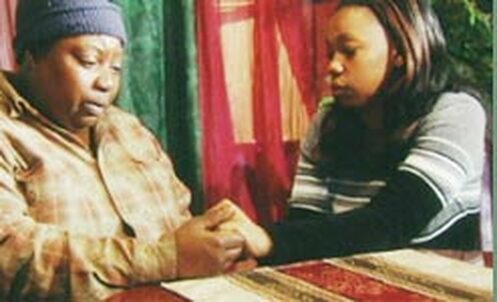 Erma Faye Stewart, a single African-American mother of two, was arrested in 2000 in a drug sweep in Hearne, Texas. She sat in jail for a week stating she was innocent, so she wasn’t going to plead guilty. Her children were placed into social services care. After sitting in jail for a month, and worried about her children's care, she pled guilty. Her court-appointed lawyer told her to take the prosecutor's deal: plead guilty so she could get out of jail and serve probation. She pled, was sentenced to 10 years’ probation, and a $1000 fine. But now she was a felon--barred from food stamps, evicted from public housing and homeless, her children were taken and placed in foster care. The raid was based on a statement made by an informant who later admitted he lied. Ironically, the cases were thrown out for everyone who pled not guilty. However, her conviction remained, because she had pled guilty.
Erma Faye Stewart, a single African-American mother of two, was arrested in 2000 in a drug sweep in Hearne, Texas. She sat in jail for a week stating she was innocent, so she wasn’t going to plead guilty. Her children were placed into social services care. After sitting in jail for a month, and worried about her children's care, she pled guilty. Her court-appointed lawyer told her to take the prosecutor's deal: plead guilty so she could get out of jail and serve probation. She pled, was sentenced to 10 years’ probation, and a $1000 fine. But now she was a felon--barred from food stamps, evicted from public housing and homeless, her children were taken and placed in foster care. The raid was based on a statement made by an informant who later admitted he lied. Ironically, the cases were thrown out for everyone who pled not guilty. However, her conviction remained, because she had pled guilty.Cliff Reynolds was about to attend to his 18-month-old daughter’s funeral, when he was taken into custody to testify as a witness in a drug case. He asked to see his daughter one last time, but was denied. He stated he hadn’t seen anything. Cliff resisted and was hauled off to jail. The charges were ultimately dropped, after he spent a month in jail. However, Cliff lost the opportunity to say goodbye to his daughter, he lost his car and he lost his job. This is the war on drugs.
 The Reagan administration first allowed police departments to keep the money and assets seized in a drug raid, to provide incentive for these investigations. The hope was that it would result in the arrests of drug lords and end the problem. Some now question if it gives some inner-city police departments incentive to maintain the drug problem as it provides a steady income. The accusation seems absurd until you see that low level dealers are serving long prison sentences and high level criminals are paying fines.
The Reagan administration first allowed police departments to keep the money and assets seized in a drug raid, to provide incentive for these investigations. The hope was that it would result in the arrests of drug lords and end the problem. Some now question if it gives some inner-city police departments incentive to maintain the drug problem as it provides a steady income. The accusation seems absurd until you see that low level dealers are serving long prison sentences and high level criminals are paying fines.  The Clinton administration passed the “3 strike” law requiring mandatory sentences of 25- 50 years for people arrested for their 3rd crime. While, like the Reagan effort, it may sound appealing on the surface, in practice it’s a failure. It results in sentencing someone for using small amounts of a drug to 25 years in prison. To put this in perspective, in other western countries, people typically don’t do more than 1 year in prison for any drug charge. In Minnesota, we run into the same problem with mandatory sentences for DWI offenses. If you can’t release DWI or drug offenders when the prisons are over-crowded, who gets released? The answer is sex offenders. It seems absurd, but this actually happens in Minnesota. This is the problem with mandatory sentences.
The Clinton administration passed the “3 strike” law requiring mandatory sentences of 25- 50 years for people arrested for their 3rd crime. While, like the Reagan effort, it may sound appealing on the surface, in practice it’s a failure. It results in sentencing someone for using small amounts of a drug to 25 years in prison. To put this in perspective, in other western countries, people typically don’t do more than 1 year in prison for any drug charge. In Minnesota, we run into the same problem with mandatory sentences for DWI offenses. If you can’t release DWI or drug offenders when the prisons are over-crowded, who gets released? The answer is sex offenders. It seems absurd, but this actually happens in Minnesota. This is the problem with mandatory sentences. 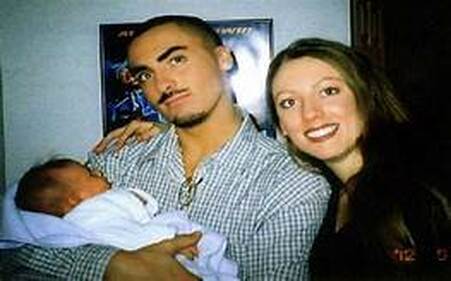 In 2015, Weldon Angeles received the mandatory Minimum of 55 years in prison for selling a small amount of marijuana. Even the judge came forward with deep regret for the sentence, but because it’s mandatory, he couldn’t change it. 75% of people sentenced through mandatory minimums are African American or Chicano.
In 2015, Weldon Angeles received the mandatory Minimum of 55 years in prison for selling a small amount of marijuana. Even the judge came forward with deep regret for the sentence, but because it’s mandatory, he couldn’t change it. 75% of people sentenced through mandatory minimums are African American or Chicano.Something else to consider: Most drug dealers in Minnesota are white. Most drug addicts in Minnesota are white. Perhaps the best measure of who is using drugs is the emergency room data for overdoses. More than 75% of people treated for drug overdoses in emergency rooms are white. More than 35% of people in prison for drug crimes in Minnesota are African American, even though they make up only 6% of our population.
1 out of every 100 Americans is incarcerated. That is 4x the number from 1980, even though violent crime has decreased since then.
The “drug war” was initially implemented to take the public’s focus off the Vietnam War and blame hippies and inner-city African Americans for the problems we face in America. To state it simple, it was a way to get the poor white people vote. Before John Kennedy was assassinated, he wanted to fight a war against poverty. If we have would seriously addressed that war, we wouldn’t have the inner-city problems we have.
Thanks for listening,
Frank
 Frank performing his coldest book tour on earth last week.
Frank performing his coldest book tour on earth last week. 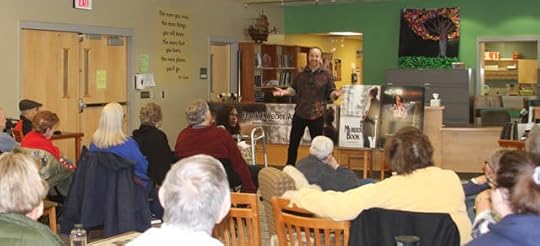
 Bottle cap art at the Pipestone library.
Bottle cap art at the Pipestone library.
Published on February 12, 2019 07:41
February 4, 2019
Shannon Schieber
A lesson in classifying sex crimes, as sex crimes.
Shannon Schieber graduated from Duke in 3 years. She then attended Wharton College in Philadelphia and was pursuing her doctorate degree when a self-centered jerk cut her life short. May 7, 1998, Shannon was studying for her last 2 final exams of the school year. Shannon’s brother had planned on coming into Philadelphia to visit. She tells him she needs to study, and asks him to come the next day instead. A neighbor hears Shannon scream at 2:00 a.m., and calls the police. The police arrive within 6 minutes, but no one answers the door. The police consider breaking the door down, but the neighbor begins questioning if the sound was from the apartment or from outside. The police can’t break down the door based on an uncertain report. Shannon’s brother, Sean, arrives the next day. When she doesn’t answer, he and the neighbor break down the door and find her dead, lying naked on the bed. Shannon was an assertive and attractive young woman attending a program that was predominantly male, so at times this put her at odds with peers. She told a man she had dated that she wanted to remain friends. He tells her, “The next funeral you may attend may be your own.” Shannon gets a restraining order. The investigators bring this guy in for DNA testing but have to release him until the results return.
Shannon was an assertive and attractive young woman attending a program that was predominantly male, so at times this put her at odds with peers. She told a man she had dated that she wanted to remain friends. He tells her, “The next funeral you may attend may be your own.” Shannon gets a restraining order. The investigators bring this guy in for DNA testing but have to release him until the results return.
At Shannon’s funeral, one of the investigators tells her parents they suspect the killer may be at her funeral. Shannon had an intense argument with a young man, only days before her death, and here he is. They interrogate him, but without evidence have to release him. The family is frustrated that a potential killer is released. The DNA tests finally come back on both men. Neither of these men killed Shannon.
Here is why you should classify crimes correctly:
A friend of Shannon’s tells investigators that a man had followed Shannon home from a movie, days before her death. Investigators then theorize that maybe Shannon wasn’t this guy’s first victim. Initially investigators can’t find any similar sexual crimes. They run the DNA and find a match to “burglaries” in the area. Once they look at the “burglaries” they realize they were sexual assaults, but they were charged as burglaries. It reveals a problem in the Philadelphia police department. They had been charging sex crimes as burglaries in an effort to make it look like sex crimes were lower, and to keep their arrest rate for sex crimes high. The police had covered up 4 previous rapes within 3 blocks of her home. Had the public been made aware of this, the community would have known there was a serial rapist on the loose, and could have been more cautious. The rapist shared with one of the victims that his mother is Italian American and his father is African American, which fits the description from other surviving victims. (Either dark white guy or light black guy—he was both.) Investigators made the information public. After August 1999, the Center City Rapist stops. In 2001, a woman working in the Philadelphia police department looks at news reports from Fort Collins, Colorado, on a serial rapist.
In 2001, a woman working in the Philadelphia police department looks at news reports from Fort Collins, Colorado, on a serial rapist.
Kristen Marshall’s husband was dying from cancer. He took his son on a last father and son camping trip and Kristen stays home. In the middle of the night a man breaks into her home. She complied as she didn’t want her son to lose both of his parents. He left her naked and tied to the bed. She managed to work herself loose and call the police. She’s told by police she’s been the 3rd woman in Fort Collins raped in a similar manner.
After the 5th attack, the killer left a baseball cap at the scene. DNA processing can be slow, and Philadelphia finally matches the DNA from Fort Collins to their crimes.
The suspect sends a letter to the Philadelphia police indicating he doesn’t like Fort Collins. He claims he didn’t kill Shannon. The Philadelphia police start cross referencing people who lived in both Philadelphia and Fort Collins. A woman in Fort Collins calls and reports that her neighbor, Troy Graves, looks like the sketch of the rapist. Graves is one of the 40 people on the list. He is married. He has high security clearance in Cheyenne, Wyoming, on an Air force base that deals with nuclear weapons. As they investigate Graves further, they find he lived in the neighborhood of all of the victims in Philadelphia and Fort Collins at the times of the assaults. His wife shares that he is gentle and she doesn’t believe he’s the rapist, but admits he struggles with insomnia and often needs to go for drives at night. Amy Wade, Troy’s wife, pictured below. Troy Graves told his wife both blacks and whites taunted him because he was of mixed race. His father, Earl Clayton Graves, a welder for General Motors, was a physically abusive heroin addict, according to both family members and Troy Graves' former partners. Graves' mother divorced Earl when Troy was 13. Troy Graves said his father, who died homeless, ignored him.
Troy Graves told his wife both blacks and whites taunted him because he was of mixed race. His father, Earl Clayton Graves, a welder for General Motors, was a physically abusive heroin addict, according to both family members and Troy Graves' former partners. Graves' mother divorced Earl when Troy was 13. Troy Graves said his father, who died homeless, ignored him.
Graves told Robinson that he had suffered extensive physical and mental abuse, and that he had been sexually molested. His molester would coerce him, he told his partner, as if the acts were mere affection: "Why don't you do this? You had a bad day. This will make you feel good. This will make me feel good." Graves victims reported he spoke to them in a similar manner.
Most people who suffer abuse do not go on to become violent themselves, but among people who do become violent criminals, it is a common factor.
Troy had been charged with harassing a female colleague in the Air Force, but had no legal charges. When interviewed, he denied the harassment allegation until he was confronted directly with it. Graves continues to deny being the rapist, but DNA evidence identifies him as the rapist and killer. Troy Graves pleads guilty in Colorado. The District Attorney in Philadelphia wants him to face the death penalty. However, Shannon’s parents don’t believe in the death penalty. They assert that they want him to wake up every day for the rest of his life in prison. Graves gets another life sentence, plus 60 years, in Philadelphia. Philadelphia attacks
Philadelphia attacks
1. June 20, 1997: a woman on South 21st Street is the target of an attempted rape by a home intruder;
2. July 11, 1997: a woman on Pine Street was raped by a home intruder;
3. August 6, 1997: a woman on Pine Street was raped by a home intruder;
4. August 13, 1997: a woman on Pine Street was raped by a home intruder;
5. May 7, 1998: Wharton School doctoral student Shannon Schieber was raped and murdered by a home intruder;
6. August 28, 1999: a woman on Naudain Street was forced to perform a sex act by a home intruder.
Fort Collins attacks
1. May 10, 2001: a woman on Raintree Drive was raped;
2. June 13, 2001: a woman on Raintree Drive was raped;
3. June 24, 2001: a woman on Battlecreek Drive was forced to perform a sex act by a home intruder;
4. July 26, 2001: a woman on Prospect Road was forced to perform a sex act by a home intruder;
5. August 5, 2001: a woman on University Avenue was raped by a home intruder;
6. August 23, 2001: a woman on Landings Drive was forced to perform a sex act by a home intruder; she scared him away after he then tried to attack her roommate. Now she is an impressive person! Graves was just one more self-centered slimeball.
Thanks for listening,
Frank I love the New Orleans jazz style SLO’s at the end. Mitch, Frank, Preston & Charlie at the New Bohemia Pub
Mitch, Frank, Preston & Charlie at the New Bohemia Pub 





















Shannon Schieber graduated from Duke in 3 years. She then attended Wharton College in Philadelphia and was pursuing her doctorate degree when a self-centered jerk cut her life short. May 7, 1998, Shannon was studying for her last 2 final exams of the school year. Shannon’s brother had planned on coming into Philadelphia to visit. She tells him she needs to study, and asks him to come the next day instead. A neighbor hears Shannon scream at 2:00 a.m., and calls the police. The police arrive within 6 minutes, but no one answers the door. The police consider breaking the door down, but the neighbor begins questioning if the sound was from the apartment or from outside. The police can’t break down the door based on an uncertain report. Shannon’s brother, Sean, arrives the next day. When she doesn’t answer, he and the neighbor break down the door and find her dead, lying naked on the bed.
 Shannon was an assertive and attractive young woman attending a program that was predominantly male, so at times this put her at odds with peers. She told a man she had dated that she wanted to remain friends. He tells her, “The next funeral you may attend may be your own.” Shannon gets a restraining order. The investigators bring this guy in for DNA testing but have to release him until the results return.
Shannon was an assertive and attractive young woman attending a program that was predominantly male, so at times this put her at odds with peers. She told a man she had dated that she wanted to remain friends. He tells her, “The next funeral you may attend may be your own.” Shannon gets a restraining order. The investigators bring this guy in for DNA testing but have to release him until the results return. At Shannon’s funeral, one of the investigators tells her parents they suspect the killer may be at her funeral. Shannon had an intense argument with a young man, only days before her death, and here he is. They interrogate him, but without evidence have to release him. The family is frustrated that a potential killer is released. The DNA tests finally come back on both men. Neither of these men killed Shannon.
Here is why you should classify crimes correctly:
A friend of Shannon’s tells investigators that a man had followed Shannon home from a movie, days before her death. Investigators then theorize that maybe Shannon wasn’t this guy’s first victim. Initially investigators can’t find any similar sexual crimes. They run the DNA and find a match to “burglaries” in the area. Once they look at the “burglaries” they realize they were sexual assaults, but they were charged as burglaries. It reveals a problem in the Philadelphia police department. They had been charging sex crimes as burglaries in an effort to make it look like sex crimes were lower, and to keep their arrest rate for sex crimes high. The police had covered up 4 previous rapes within 3 blocks of her home. Had the public been made aware of this, the community would have known there was a serial rapist on the loose, and could have been more cautious. The rapist shared with one of the victims that his mother is Italian American and his father is African American, which fits the description from other surviving victims. (Either dark white guy or light black guy—he was both.) Investigators made the information public. After August 1999, the Center City Rapist stops.
 In 2001, a woman working in the Philadelphia police department looks at news reports from Fort Collins, Colorado, on a serial rapist.
In 2001, a woman working in the Philadelphia police department looks at news reports from Fort Collins, Colorado, on a serial rapist. Kristen Marshall’s husband was dying from cancer. He took his son on a last father and son camping trip and Kristen stays home. In the middle of the night a man breaks into her home. She complied as she didn’t want her son to lose both of his parents. He left her naked and tied to the bed. She managed to work herself loose and call the police. She’s told by police she’s been the 3rd woman in Fort Collins raped in a similar manner.
After the 5th attack, the killer left a baseball cap at the scene. DNA processing can be slow, and Philadelphia finally matches the DNA from Fort Collins to their crimes.
The suspect sends a letter to the Philadelphia police indicating he doesn’t like Fort Collins. He claims he didn’t kill Shannon. The Philadelphia police start cross referencing people who lived in both Philadelphia and Fort Collins. A woman in Fort Collins calls and reports that her neighbor, Troy Graves, looks like the sketch of the rapist. Graves is one of the 40 people on the list. He is married. He has high security clearance in Cheyenne, Wyoming, on an Air force base that deals with nuclear weapons. As they investigate Graves further, they find he lived in the neighborhood of all of the victims in Philadelphia and Fort Collins at the times of the assaults. His wife shares that he is gentle and she doesn’t believe he’s the rapist, but admits he struggles with insomnia and often needs to go for drives at night. Amy Wade, Troy’s wife, pictured below.
 Troy Graves told his wife both blacks and whites taunted him because he was of mixed race. His father, Earl Clayton Graves, a welder for General Motors, was a physically abusive heroin addict, according to both family members and Troy Graves' former partners. Graves' mother divorced Earl when Troy was 13. Troy Graves said his father, who died homeless, ignored him.
Troy Graves told his wife both blacks and whites taunted him because he was of mixed race. His father, Earl Clayton Graves, a welder for General Motors, was a physically abusive heroin addict, according to both family members and Troy Graves' former partners. Graves' mother divorced Earl when Troy was 13. Troy Graves said his father, who died homeless, ignored him.Graves told Robinson that he had suffered extensive physical and mental abuse, and that he had been sexually molested. His molester would coerce him, he told his partner, as if the acts were mere affection: "Why don't you do this? You had a bad day. This will make you feel good. This will make me feel good." Graves victims reported he spoke to them in a similar manner.
Most people who suffer abuse do not go on to become violent themselves, but among people who do become violent criminals, it is a common factor.
Troy had been charged with harassing a female colleague in the Air Force, but had no legal charges. When interviewed, he denied the harassment allegation until he was confronted directly with it. Graves continues to deny being the rapist, but DNA evidence identifies him as the rapist and killer. Troy Graves pleads guilty in Colorado. The District Attorney in Philadelphia wants him to face the death penalty. However, Shannon’s parents don’t believe in the death penalty. They assert that they want him to wake up every day for the rest of his life in prison. Graves gets another life sentence, plus 60 years, in Philadelphia.
 Philadelphia attacks
Philadelphia attacks1. June 20, 1997: a woman on South 21st Street is the target of an attempted rape by a home intruder;
2. July 11, 1997: a woman on Pine Street was raped by a home intruder;
3. August 6, 1997: a woman on Pine Street was raped by a home intruder;
4. August 13, 1997: a woman on Pine Street was raped by a home intruder;
5. May 7, 1998: Wharton School doctoral student Shannon Schieber was raped and murdered by a home intruder;
6. August 28, 1999: a woman on Naudain Street was forced to perform a sex act by a home intruder.
Fort Collins attacks
1. May 10, 2001: a woman on Raintree Drive was raped;
2. June 13, 2001: a woman on Raintree Drive was raped;
3. June 24, 2001: a woman on Battlecreek Drive was forced to perform a sex act by a home intruder;
4. July 26, 2001: a woman on Prospect Road was forced to perform a sex act by a home intruder;
5. August 5, 2001: a woman on University Avenue was raped by a home intruder;
6. August 23, 2001: a woman on Landings Drive was forced to perform a sex act by a home intruder; she scared him away after he then tried to attack her roommate. Now she is an impressive person! Graves was just one more self-centered slimeball.
Thanks for listening,
Frank I love the New Orleans jazz style SLO’s at the end.
 Mitch, Frank, Preston & Charlie at the New Bohemia Pub
Mitch, Frank, Preston & Charlie at the New Bohemia Pub 





















Published on February 04, 2019 07:49
January 28, 2019
It’s just another manic Bunday…
Frank’s presentations at the Albany and St. Michael libraries have been postponed 1 week so Tuesday, February 5 he will be speaking at the Albany library at 6:00 p.m. and Wednesday, February 6, he will be speaking at the St. Michael library at 6:30 p.m. Each presentation of forensic work and True Crime thrillers lasts a little over an hour. He will be selling and signing books after for those interested. 

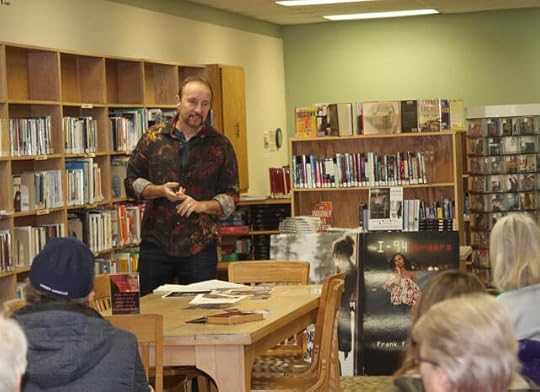 Frank speaking in Belgrade The city of North Pole, Alaska is 1700 miles south of the geological North Pole. The streets have holiday names, and stores sell Christmas-themed items year-round. The town’s biggest attraction is a large gift shop named Santa Claus House, which boasts the world’s largest fiberglass statue of Santa. North Pole sits south of Fairbanks and stretches between Fort Wainwright and Eielson Air Force Base. From 1979 to 1981, 5 females were murdered in the small community.
Frank speaking in Belgrade The city of North Pole, Alaska is 1700 miles south of the geological North Pole. The streets have holiday names, and stores sell Christmas-themed items year-round. The town’s biggest attraction is a large gift shop named Santa Claus House, which boasts the world’s largest fiberglass statue of Santa. North Pole sits south of Fairbanks and stretches between Fort Wainwright and Eielson Air Force Base. From 1979 to 1981, 5 females were murdered in the small community.  Glinda Sodemann, 19
Glinda Sodemann, 19
Glinda Sodemann, 19, vanished from her home in North Pole on August 29, 1979. Glinda was a newlywed and the daughter of an Alaska State Trooper. Glinda and her husband had a small baby, and when her husband arrived home on August 29, the baby was in the crib, but Glinda was gone. By all accounts, Glinda was happy and had no reason to run away from her home.
The following October, Glinda’s decomposed body was found in a gravel pit near Moose Creek on the Richardson Highway, not far from Eielson Air Force Base. Glinda had been shot in the face, and troopers found a .38 caliber pistol cartridge near her body. The medical examiner discovered no evidence suggesting Glinda had been sexually assaulted. Suspicion fell on Glinda’s new husband who failed a lie detector test. Even Glinda’s father suspected his son-in-law of the crime, but troopers found no evidence to arrest the husband.
Doris Oehring, 11
On June 11, 1980, eleven-year-old Doris Oehring and her older brother were riding bikes together on the roads in North Pole. Doris cycled ahead of her brother, and when her brother caught up with her, he saw his sister talking to a strange man in a blue car. The man had propped open the hood of the car, as if he was having engine problems. When Doris’s brother pulled up, the man quickly shut the hood, jumped in the car, and sped away. The brother was later able to describe the man to a police sketch artist. He told police he thought the man’s blue shirt looked like an Air Force uniform, and the man had a military style haircut.
Two days later, Doris disappeared, and her bicycle was found hidden in the bushes along Badger Road near her home in North Pole. A witness reported seeing a small, blue car tear around the corner at an intersection near Badger Road. The driver seemed pre-occupied and was wrestling with something or someone in the seat next to him. Police believe the attacker hid in the bushes on the side of the road and waited for Doris to ride her bike past his hiding spot. Once she got close, he jumped out of the brush, grabbed her off her bike, and tossed the bike into the ditch.
State troopers asked security at Eielson Air Force Base for a list of blue cars registered to drive on the base. The Air Force handed the troopers a list of 550 names of people who owned vehicles possibly matching the description of the car. Investigators were desperate to find Doris, but with no fingerprints or other forensic evidence, they didn’t know where to begin.
Since troopers had not cleared Glinda Sodemann’s husband for Glinda’s murder, they decided to question him about the abduction of Doris Oehring. They gave him another polygraph test, and this time, the polygrapher found the test results inconclusive. They had no physical evidence pointing to Sodemann, but he could not pass a lie detector test when questioned about the murder of his wife or the abduction of the young girl. Troopers decided to bring in a polygraph expert to question Sodemann. After ten minutes, the expert left the examining room and told troopers that Sodemann had an irregular heartbeat. He could never pass a polygraph test. The test results from an individual with a heartbeat like Sodemann’s would always be classified as inconclusive or failing. Since the troopers had no reason other than his lie-detector test results to suspect Sodemann, they dismissed him as a suspect in the disappearance of Doris.
Marlene Peters, 20
On January 31, a little over seven months after someone snatched Doris Oehring, twenty-year-old Marlene Peters disappeared. Marlene was last seen trying to hitch a ride from Fairbanks to Anchorage to visit her father who was sick with cancer. Police considered Marlene’s disappearance suspicious, but they had no way to know if someone had abducted Marlene near Fairbanks or if she had disappeared somewhere else between Fairbanks and Anchorage. Troopers did not immediately link her case to Doris Oehring’s or Glinda Sodemann’s.
Wendy Wilson, 16
Five months after Marlene disappeared, sixteen-year-old Wendy Wilson vanished. Wendy was last seen hitchhiking, and a witness saw her climb into a white pickup truck in Moose Creek near Fairbanks. Three days after she disappeared, Wendy Wilson’s body was found near Johnson Road, thirty-two miles south of Fairbanks near the trans-Alaska pipeline. Wendy’s killer had strangled her and then fired a shotgun into her face.
Nine weeks after the discovery of Wendy Wilson’s body, Marlene Peters’ remains were found. Marlene also had been dumped near Johnson Road, and she was found only two miles from where Wendy had been dumped. Marlene also had been strangled and then shot in the face with a shotgun.
Lori King, 19
Two days after police recovered Marlene Peters’s body, they were notified of the disappearance of nineteen-year-old Lori King. Lori had last been seen walking in Fairbanks.
The Fairbanks police and the Alaska State Troopers now knew they had a serial killer operating in and near North Pole, outside of Fairbanks. Soon, the news media labeled the string of murders, “The Fairbanks Serial Murders.”
Police, as well as civilian and military volunteers, searched for Doris Oehring’s and Lori King’s bodies near the Johnson Road area where the remains of Wendy Wilson and Marlene Peters had been discovered, but they found no sign of either victim.
On September 2, 1981, four airmen on a hunting trip came across the remains of Lori King in a wooded area near a missile site off Johnson Road. Earlier searches had somehow missed this area. The killer had done nothing to hide Lori’s body. Like Wendy and Marlene, Lori had been strangled and then shot in the face with a shotgun.
Because Lori’s body was found on a federal reservation, the FBI joined the case, and a task force was formed. Investigators now knew they were hunting a dangerous predator. Some, but not all, of the women showed signs of being raped before they were murdered.
An investigator from the Eielson AFB Office of Special Investigations reported he had identified three individuals on the base who acted inappropriately toward women. One of the three men he identified was Technical Sergeant Thomas “Richard” Bunday, a 33-year-old electrical expert. Co-workers said Bunday repeatedly showed disrespect toward women, and one woman who worked with Bunday said he was verbally abusive, and she was afraid of him.
It is important to note that “profiles” are theories and not solid evidence. Profiles are often useful, but not always. The FBI profilers believed the murderer was a civilian who was single, lived alone, and could not hold a job. Bunday was married, had children, and was enlisted in the military. The task force had identified several suspects who fit the profile better than Bunday.
After Lori King was murdered on May 16, 1981, the murders ended. In September of 1981, hunters discovered the body of Lori King. It was another body near Johnson Road. By November 1982, the task force concluded the murderer was either dead, in prison, or had moved somewhere else. The task force decided they needed to look at military personnel who had transferred outside the state in the past 18 months.
Who was on the list? Thomas “Richard” Bunday. Bunday had transferred to Sheppard Air Force Base near Wichita Falls, Texas, on September 9, 1981. They contacted police agencies near other U.S. Air Force bases around the world and asked them to be on the lookout for any murders similar to the ones perpetrated near Fairbanks. Wichita Falls police reported investigating a murder similar to the ones that had occurred near Fairbanks. But when Alaska investigators arrived in in Texas to discuss the murder, they found a sheriff sitting at his desk watching television and reading a newspaper who told them, “They are no unsolved crimes in my county.” The sheriff said Lori had been killed by a drug dealer, who was now dead.
Doris Oehring’s younger brother’s identified a photo of Bunday in a line-up, and he had no trouble picking out a photo of Bunday’s car as the vehicle he had seen by his sister two days before her abduction. Troopers interviewed Bunday’s Alaska neighbors and co-workers, and most painted an unflattering picture of Bunday. They described him as an unlikeable loner. Bunday had a variety of shotguns and pistols registered to his name. Thomas Richard Bunday In January 1983, Trooper Sam Barnard flew to Sheppard Air Force Base and interviewed Richard Bunday. Bunday agreed to answer Barnard’s questions, but refused to take a lie detector test, allow a search of his home, or give samples of his hair. When Barnard told Bunday that Doris Oehring’s brother had identified a photo of Bunday as the man he had seen talking to his sister, Bunday didn’t respond.
Thomas Richard Bunday In January 1983, Trooper Sam Barnard flew to Sheppard Air Force Base and interviewed Richard Bunday. Bunday agreed to answer Barnard’s questions, but refused to take a lie detector test, allow a search of his home, or give samples of his hair. When Barnard told Bunday that Doris Oehring’s brother had identified a photo of Bunday as the man he had seen talking to his sister, Bunday didn’t respond.
Still, they didn’t feel they had enough evidence to arrest him. Alaska investigators had no authority to arrest someone in Texas, and the Texas police needed a warrant to arrest someone for crimes committed in Alaska.
Richard Bunday agreed to come in and talk to investigators, as requested, without an attorney. This is not surprising to me as psychopaths have extreme narcissism and feel they can outsmart investigators. After several days of speaking to him, for 3 hours at a time, Richard Bunday gave his only denial. “I really enjoy talking to you guys, but you say I did these things and I didn’t.” In a search of his home in Texas, they found an article on the murders from a newspaper in Fairbanks, Alaska. Later during a phone call, finally Richard admitted that the bodies found “weren’t all of them.” Bunday returned the next day to talk to the officers. They shared that the family of 11-year-old Doris Oehring was upset that they didn’t have her body. Richard started crying and stated he didn’t know why he did it. He admitted that he had strangled her and drove in his trunk on to the airforce base in which he worked. In 1986, three years after Bunday’s death and a few months after Doris Oehring should have graduated from high school, Doris’s skull was found in a remote section of Eielson Air Force Base.
Richard Bunday’s job allowed him to set up high powered cameras so he could watch places from the military base where he committed the crimes, so he could observe investigators as they worked the crimes. Investigators believe Bunday committed the five murders in Alaska, and the one in Texas. They believe he denied the murder in Texas because Texas had the death penalty and Texas police couldn’t arrest him (until a significant amount of paperwork went through) if he was only charged with crimes in Alaska.
The Alaska troopers had a problem. They had no power to arrest him outside of Alaska. All flights headed from Texas to Alaska have a layover in Seattle. If Bunday decided not to go to Alaska, he could freely walk. Hearing of the dilemma, the Texas governor gave them access to a private jet that would make a direct flight to Alaska on March 16.
March 16, 1983 was dark and eerie. There were tornado watches throughout Texas. Bunday had slipped by their security guards and escaped surveillance. After first dropping off his taxes at H&R Block, Bunday took the Sons of Anarchy ending. He drove over 100 miles an hour on his motorcycle, straight into the front of an oncoming semi-truck. The truck driver stated he tried to avoid him, but Bunday kept coming at him, and that was the end of Richard Bunday. Richard Bunday’s motorcycle after the crash. Lab reports finally started coming in indicating hairs found in Bunday’s truck genetically matched Wendy Williams. Shotgun shells found in the home matched the shells at two of the crime scenes. August 1986, Doris Oehring’s skull was found in a remote area of Eilson Airforce base. I watched interviews of Doris’ friends and they sadly still blame themselves for not being with Doris on that day.
Richard Bunday’s motorcycle after the crash. Lab reports finally started coming in indicating hairs found in Bunday’s truck genetically matched Wendy Williams. Shotgun shells found in the home matched the shells at two of the crime scenes. August 1986, Doris Oehring’s skull was found in a remote area of Eilson Airforce base. I watched interviews of Doris’ friends and they sadly still blame themselves for not being with Doris on that day.
The root of Thomas “Richard” Bunday’s anger appears to be early childhood trauma. Richard was severely beaten by his father and they had a tumultuous relationship. A sibling commented that their father died before Richard was “able to prove himself to his father.” Even though it was his father who was abusive, Richard hated women (misogynist). This is not uncommon, as a child may view an abusive dad as a monster, but mom is someone who is loving—yet he feels betrayed when mom doesn’t protect him. He views her weakness and powerlessness as despicable. It is never in the best interests of a child for a couple to stay in an abusive relationship, and often the child will hate both parents for it. From my own history of assessing offenders, I’d also bet that Bunday had been confronted by his father over an offense he had against a young girl which created extreme shame for him. (Thus the blast in the face. He needed it to go away.) The good news…. It’s over. Alaska investigators focused on the evidence, and didn’t get sidetracked by the incorrect FBI profile. Picture from North Pole, Alaska
Picture from North Pole, Alaska
Thanks for listening,
Frank
John Prine writes some nice lyrics, like the beginning of Storm Windows
I can hear the wheels of the automobiles
So far away - just moving along through the drifting snow
It's times like these when the temperatures freeze
I sit alone just looking at the world through a storm window














 Upsala beats Long Prairie when Amber Biniek drains a 3 on the buzzer in overtime.
Upsala beats Long Prairie when Amber Biniek drains a 3 on the buzzer in overtime.


 Frank speaking in Belgrade The city of North Pole, Alaska is 1700 miles south of the geological North Pole. The streets have holiday names, and stores sell Christmas-themed items year-round. The town’s biggest attraction is a large gift shop named Santa Claus House, which boasts the world’s largest fiberglass statue of Santa. North Pole sits south of Fairbanks and stretches between Fort Wainwright and Eielson Air Force Base. From 1979 to 1981, 5 females were murdered in the small community.
Frank speaking in Belgrade The city of North Pole, Alaska is 1700 miles south of the geological North Pole. The streets have holiday names, and stores sell Christmas-themed items year-round. The town’s biggest attraction is a large gift shop named Santa Claus House, which boasts the world’s largest fiberglass statue of Santa. North Pole sits south of Fairbanks and stretches between Fort Wainwright and Eielson Air Force Base. From 1979 to 1981, 5 females were murdered in the small community.  Glinda Sodemann, 19
Glinda Sodemann, 19Glinda Sodemann, 19, vanished from her home in North Pole on August 29, 1979. Glinda was a newlywed and the daughter of an Alaska State Trooper. Glinda and her husband had a small baby, and when her husband arrived home on August 29, the baby was in the crib, but Glinda was gone. By all accounts, Glinda was happy and had no reason to run away from her home.
The following October, Glinda’s decomposed body was found in a gravel pit near Moose Creek on the Richardson Highway, not far from Eielson Air Force Base. Glinda had been shot in the face, and troopers found a .38 caliber pistol cartridge near her body. The medical examiner discovered no evidence suggesting Glinda had been sexually assaulted. Suspicion fell on Glinda’s new husband who failed a lie detector test. Even Glinda’s father suspected his son-in-law of the crime, but troopers found no evidence to arrest the husband.
Doris Oehring, 11
On June 11, 1980, eleven-year-old Doris Oehring and her older brother were riding bikes together on the roads in North Pole. Doris cycled ahead of her brother, and when her brother caught up with her, he saw his sister talking to a strange man in a blue car. The man had propped open the hood of the car, as if he was having engine problems. When Doris’s brother pulled up, the man quickly shut the hood, jumped in the car, and sped away. The brother was later able to describe the man to a police sketch artist. He told police he thought the man’s blue shirt looked like an Air Force uniform, and the man had a military style haircut.
Two days later, Doris disappeared, and her bicycle was found hidden in the bushes along Badger Road near her home in North Pole. A witness reported seeing a small, blue car tear around the corner at an intersection near Badger Road. The driver seemed pre-occupied and was wrestling with something or someone in the seat next to him. Police believe the attacker hid in the bushes on the side of the road and waited for Doris to ride her bike past his hiding spot. Once she got close, he jumped out of the brush, grabbed her off her bike, and tossed the bike into the ditch.
State troopers asked security at Eielson Air Force Base for a list of blue cars registered to drive on the base. The Air Force handed the troopers a list of 550 names of people who owned vehicles possibly matching the description of the car. Investigators were desperate to find Doris, but with no fingerprints or other forensic evidence, they didn’t know where to begin.
Since troopers had not cleared Glinda Sodemann’s husband for Glinda’s murder, they decided to question him about the abduction of Doris Oehring. They gave him another polygraph test, and this time, the polygrapher found the test results inconclusive. They had no physical evidence pointing to Sodemann, but he could not pass a lie detector test when questioned about the murder of his wife or the abduction of the young girl. Troopers decided to bring in a polygraph expert to question Sodemann. After ten minutes, the expert left the examining room and told troopers that Sodemann had an irregular heartbeat. He could never pass a polygraph test. The test results from an individual with a heartbeat like Sodemann’s would always be classified as inconclusive or failing. Since the troopers had no reason other than his lie-detector test results to suspect Sodemann, they dismissed him as a suspect in the disappearance of Doris.
Marlene Peters, 20
On January 31, a little over seven months after someone snatched Doris Oehring, twenty-year-old Marlene Peters disappeared. Marlene was last seen trying to hitch a ride from Fairbanks to Anchorage to visit her father who was sick with cancer. Police considered Marlene’s disappearance suspicious, but they had no way to know if someone had abducted Marlene near Fairbanks or if she had disappeared somewhere else between Fairbanks and Anchorage. Troopers did not immediately link her case to Doris Oehring’s or Glinda Sodemann’s.
Wendy Wilson, 16
Five months after Marlene disappeared, sixteen-year-old Wendy Wilson vanished. Wendy was last seen hitchhiking, and a witness saw her climb into a white pickup truck in Moose Creek near Fairbanks. Three days after she disappeared, Wendy Wilson’s body was found near Johnson Road, thirty-two miles south of Fairbanks near the trans-Alaska pipeline. Wendy’s killer had strangled her and then fired a shotgun into her face.
Nine weeks after the discovery of Wendy Wilson’s body, Marlene Peters’ remains were found. Marlene also had been dumped near Johnson Road, and she was found only two miles from where Wendy had been dumped. Marlene also had been strangled and then shot in the face with a shotgun.
Lori King, 19
Two days after police recovered Marlene Peters’s body, they were notified of the disappearance of nineteen-year-old Lori King. Lori had last been seen walking in Fairbanks.
The Fairbanks police and the Alaska State Troopers now knew they had a serial killer operating in and near North Pole, outside of Fairbanks. Soon, the news media labeled the string of murders, “The Fairbanks Serial Murders.”
Police, as well as civilian and military volunteers, searched for Doris Oehring’s and Lori King’s bodies near the Johnson Road area where the remains of Wendy Wilson and Marlene Peters had been discovered, but they found no sign of either victim.
On September 2, 1981, four airmen on a hunting trip came across the remains of Lori King in a wooded area near a missile site off Johnson Road. Earlier searches had somehow missed this area. The killer had done nothing to hide Lori’s body. Like Wendy and Marlene, Lori had been strangled and then shot in the face with a shotgun.
Because Lori’s body was found on a federal reservation, the FBI joined the case, and a task force was formed. Investigators now knew they were hunting a dangerous predator. Some, but not all, of the women showed signs of being raped before they were murdered.
An investigator from the Eielson AFB Office of Special Investigations reported he had identified three individuals on the base who acted inappropriately toward women. One of the three men he identified was Technical Sergeant Thomas “Richard” Bunday, a 33-year-old electrical expert. Co-workers said Bunday repeatedly showed disrespect toward women, and one woman who worked with Bunday said he was verbally abusive, and she was afraid of him.
It is important to note that “profiles” are theories and not solid evidence. Profiles are often useful, but not always. The FBI profilers believed the murderer was a civilian who was single, lived alone, and could not hold a job. Bunday was married, had children, and was enlisted in the military. The task force had identified several suspects who fit the profile better than Bunday.
After Lori King was murdered on May 16, 1981, the murders ended. In September of 1981, hunters discovered the body of Lori King. It was another body near Johnson Road. By November 1982, the task force concluded the murderer was either dead, in prison, or had moved somewhere else. The task force decided they needed to look at military personnel who had transferred outside the state in the past 18 months.
Who was on the list? Thomas “Richard” Bunday. Bunday had transferred to Sheppard Air Force Base near Wichita Falls, Texas, on September 9, 1981. They contacted police agencies near other U.S. Air Force bases around the world and asked them to be on the lookout for any murders similar to the ones perpetrated near Fairbanks. Wichita Falls police reported investigating a murder similar to the ones that had occurred near Fairbanks. But when Alaska investigators arrived in in Texas to discuss the murder, they found a sheriff sitting at his desk watching television and reading a newspaper who told them, “They are no unsolved crimes in my county.” The sheriff said Lori had been killed by a drug dealer, who was now dead.
Doris Oehring’s younger brother’s identified a photo of Bunday in a line-up, and he had no trouble picking out a photo of Bunday’s car as the vehicle he had seen by his sister two days before her abduction. Troopers interviewed Bunday’s Alaska neighbors and co-workers, and most painted an unflattering picture of Bunday. They described him as an unlikeable loner. Bunday had a variety of shotguns and pistols registered to his name.
 Thomas Richard Bunday In January 1983, Trooper Sam Barnard flew to Sheppard Air Force Base and interviewed Richard Bunday. Bunday agreed to answer Barnard’s questions, but refused to take a lie detector test, allow a search of his home, or give samples of his hair. When Barnard told Bunday that Doris Oehring’s brother had identified a photo of Bunday as the man he had seen talking to his sister, Bunday didn’t respond.
Thomas Richard Bunday In January 1983, Trooper Sam Barnard flew to Sheppard Air Force Base and interviewed Richard Bunday. Bunday agreed to answer Barnard’s questions, but refused to take a lie detector test, allow a search of his home, or give samples of his hair. When Barnard told Bunday that Doris Oehring’s brother had identified a photo of Bunday as the man he had seen talking to his sister, Bunday didn’t respond. Still, they didn’t feel they had enough evidence to arrest him. Alaska investigators had no authority to arrest someone in Texas, and the Texas police needed a warrant to arrest someone for crimes committed in Alaska.
Richard Bunday agreed to come in and talk to investigators, as requested, without an attorney. This is not surprising to me as psychopaths have extreme narcissism and feel they can outsmart investigators. After several days of speaking to him, for 3 hours at a time, Richard Bunday gave his only denial. “I really enjoy talking to you guys, but you say I did these things and I didn’t.” In a search of his home in Texas, they found an article on the murders from a newspaper in Fairbanks, Alaska. Later during a phone call, finally Richard admitted that the bodies found “weren’t all of them.” Bunday returned the next day to talk to the officers. They shared that the family of 11-year-old Doris Oehring was upset that they didn’t have her body. Richard started crying and stated he didn’t know why he did it. He admitted that he had strangled her and drove in his trunk on to the airforce base in which he worked. In 1986, three years after Bunday’s death and a few months after Doris Oehring should have graduated from high school, Doris’s skull was found in a remote section of Eielson Air Force Base.
Richard Bunday’s job allowed him to set up high powered cameras so he could watch places from the military base where he committed the crimes, so he could observe investigators as they worked the crimes. Investigators believe Bunday committed the five murders in Alaska, and the one in Texas. They believe he denied the murder in Texas because Texas had the death penalty and Texas police couldn’t arrest him (until a significant amount of paperwork went through) if he was only charged with crimes in Alaska.
The Alaska troopers had a problem. They had no power to arrest him outside of Alaska. All flights headed from Texas to Alaska have a layover in Seattle. If Bunday decided not to go to Alaska, he could freely walk. Hearing of the dilemma, the Texas governor gave them access to a private jet that would make a direct flight to Alaska on March 16.
March 16, 1983 was dark and eerie. There were tornado watches throughout Texas. Bunday had slipped by their security guards and escaped surveillance. After first dropping off his taxes at H&R Block, Bunday took the Sons of Anarchy ending. He drove over 100 miles an hour on his motorcycle, straight into the front of an oncoming semi-truck. The truck driver stated he tried to avoid him, but Bunday kept coming at him, and that was the end of Richard Bunday.
 Richard Bunday’s motorcycle after the crash. Lab reports finally started coming in indicating hairs found in Bunday’s truck genetically matched Wendy Williams. Shotgun shells found in the home matched the shells at two of the crime scenes. August 1986, Doris Oehring’s skull was found in a remote area of Eilson Airforce base. I watched interviews of Doris’ friends and they sadly still blame themselves for not being with Doris on that day.
Richard Bunday’s motorcycle after the crash. Lab reports finally started coming in indicating hairs found in Bunday’s truck genetically matched Wendy Williams. Shotgun shells found in the home matched the shells at two of the crime scenes. August 1986, Doris Oehring’s skull was found in a remote area of Eilson Airforce base. I watched interviews of Doris’ friends and they sadly still blame themselves for not being with Doris on that day.The root of Thomas “Richard” Bunday’s anger appears to be early childhood trauma. Richard was severely beaten by his father and they had a tumultuous relationship. A sibling commented that their father died before Richard was “able to prove himself to his father.” Even though it was his father who was abusive, Richard hated women (misogynist). This is not uncommon, as a child may view an abusive dad as a monster, but mom is someone who is loving—yet he feels betrayed when mom doesn’t protect him. He views her weakness and powerlessness as despicable. It is never in the best interests of a child for a couple to stay in an abusive relationship, and often the child will hate both parents for it. From my own history of assessing offenders, I’d also bet that Bunday had been confronted by his father over an offense he had against a young girl which created extreme shame for him. (Thus the blast in the face. He needed it to go away.) The good news…. It’s over. Alaska investigators focused on the evidence, and didn’t get sidetracked by the incorrect FBI profile.
 Picture from North Pole, Alaska
Picture from North Pole, Alaska Thanks for listening,
Frank
John Prine writes some nice lyrics, like the beginning of Storm Windows
I can hear the wheels of the automobiles
So far away - just moving along through the drifting snow
It's times like these when the temperatures freeze
I sit alone just looking at the world through a storm window














 Upsala beats Long Prairie when Amber Biniek drains a 3 on the buzzer in overtime.
Upsala beats Long Prairie when Amber Biniek drains a 3 on the buzzer in overtime.
Published on January 28, 2019 11:27



